The history of the Yarmouk camp is a microcosm of the region’s history since the beginning of the Assad clan’s dictatorship, which can be described as national socialist. It provides a snapshot of the power relations and political loyalties that have led to the violent fracturing of Syrian and Palestinian societies since the mid-1950s. Yarmouk has also been a microcosm of the uprising and civil war that have ravaged Syria since 2011. Here is a comprehensive review of the chronology of the last fourteen years…
Non-exhaustive presentation of the camp
The Yarmouk refugee camp was established in 1957 on the outskirts of Damascus, covering an area of 2.11 square kilometers bordered to the north by Al-Midan district (Al-Qa’a and Al-Zahera neighborhoods), to the west by Al-Qadam district (Qadam Sharqi and Jouret Shreibati neighborhoods), to the east by Tadamon, and to the south by Yalda, Taqaddom, and Al-Hajar al-Aswad. Its residents fled Palestine in 1948, and some of them passed through Lebanon or Jordan before reaching Syria. The camp gradually expanded eastward after 1967, welcoming refugees from the Golan Heights (including Druze—25%, Turkmen, and Alawites—3%), most of whom settled in the neighboring district of Tadamon. Strictly speaking, the Yarmouk camp initially referred to the area bounded by the 30th Street to the west and Yarmouk Street to the east, then the entire area extending to Palestine Street (see map). In some articles and reports, the camp is incorrectly divided into two separate camps, “Yarmouk camp” and “Palestine camp,” but this division does not correspond to any administrative reality. Similarly, the districts of Al-Hajar al-Aswad and Taqaddom are sometimes included in the name “Yarmouk camp” because some of their residents were also refugees from Palestine.
In 2011, Yarmouk was the largest Palestinian refugee camp among the 12 camps in Syria. At the beginning of the uprising, Yarmouk had 351,500 Syrian residents and 171,880 Palestinian refugees (44,279 families). UNRWA administered 23 facilities there, including 16 schools, three medical centers, a Youth Cultural Center, an Educational Development Center, and two Community Centers [1]. In addition to the schools run by UNRWA, there were seven public schools. There were also 11 mosques in Yarmouk, as the population was almost exclusively Sunni Muslim.
The administrative management of the camp was entrusted to a municipality affiliated with the Ba’ath Party and Palestinian factions loyal to it, led by the Popular Front for the Liberation of Palestine – General Command (PFLP-GC). The main Palestinian factions present and active in Yarmouk at the start of the uprising were loyal to Bashar al-Assad’s regime:
- Popular Front for the Liberation of Palestine – General Command (PFLP-GC), a splinter group of the PFLP founded in 1968, which left the PLO in 1974. Led by Ahmad Jibril, Talal Naji, and Anwar Raja;
- Palestine Liberation Army (PLA – Jaysh al-Tahrir al-Falastini), founded by the PLO in 1964, then subservient to the Syrian Ba’ath Party and expelled from the PLO in 1973. Led by Akram Muhammad al-Salti;
- Fatah al-Intifada (translated as “The Fatah Uprising”), a splinter group of Fatah founded in 1983 and expelled from the PLO the same year. Led by Saïd al-Mouragha “Abu Mussa” until 2013, then Ziad al-Saghir “Abu Hazim”;
- As-Sa’iqa (translated as “lightning strike”), the Palestinian branch of the Syrian Ba’ath Party founded in 1966. Led by Mohammed Qeis.
- Harakat Falasteen Hurra (translated as “Free Palestine Movement”), founded in 2003 and led by Yasser Qashlak and Saed Abd Al-Aal.
However, they did not represent the majority of Palestinians in Yarmouk and owed their existence solely to their loyalty to the regime, as other Palestinian movements were banned. Hamas, meanwhile, had enjoyed a presence in Syria since 1999 that was both largely symbolic, due to its membership in the “Axis of Resistance,” and closely controlled, due to its historical affiliation with the Muslim Brotherhood, which had been violently persecuted by the regime since the 1980s.
[1] UNRWA Website – https://www.unrwa.org/where-we-work/syria/yarmouk-unofficial-camp
Map 1: Location of Yarmouk regarding Damascus (green square = Map 2)
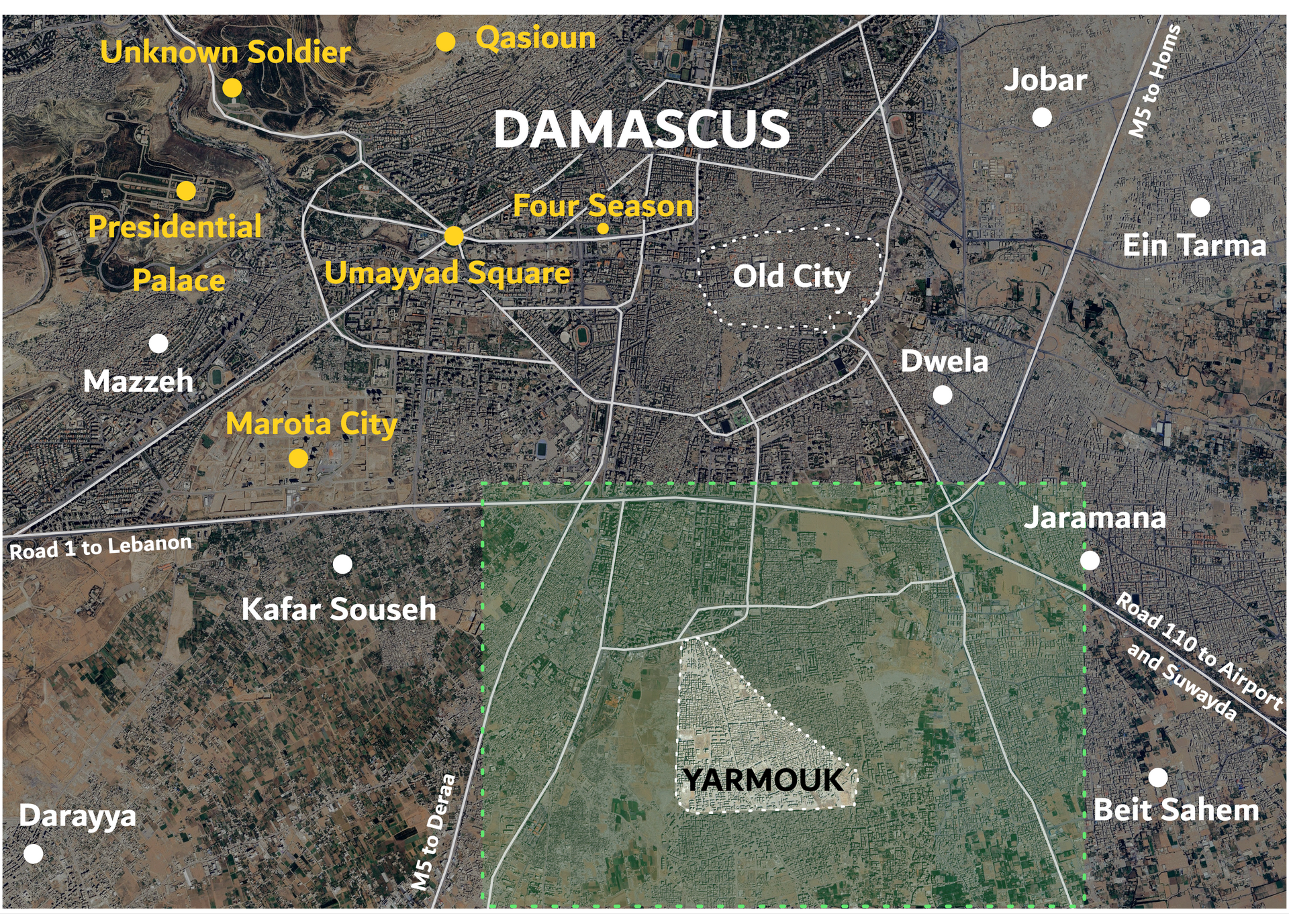
Map 2: Neighborhoods and districts located around Yarmouk.
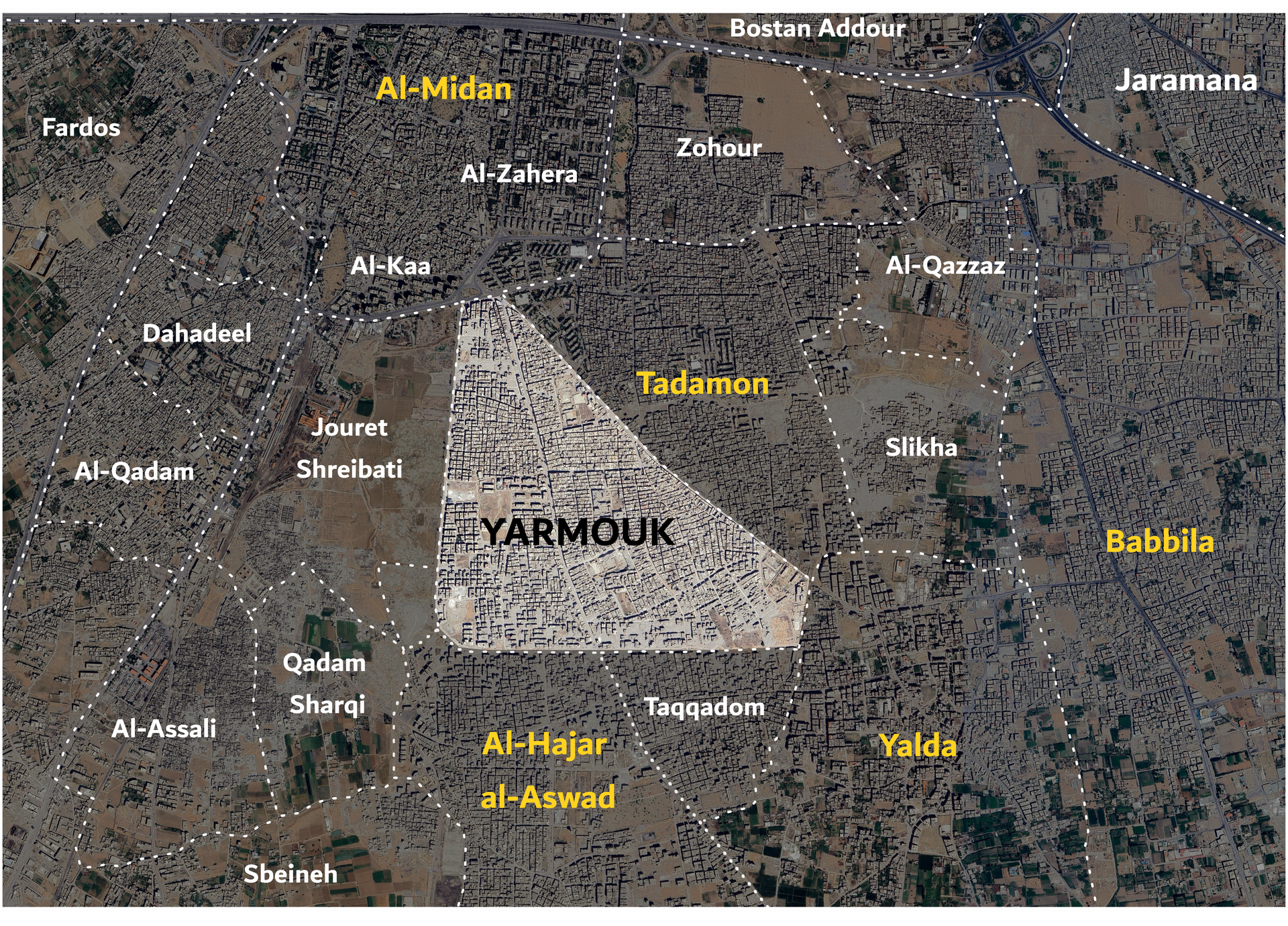
Map 3: Infrastructure of the Yarmouk camp.
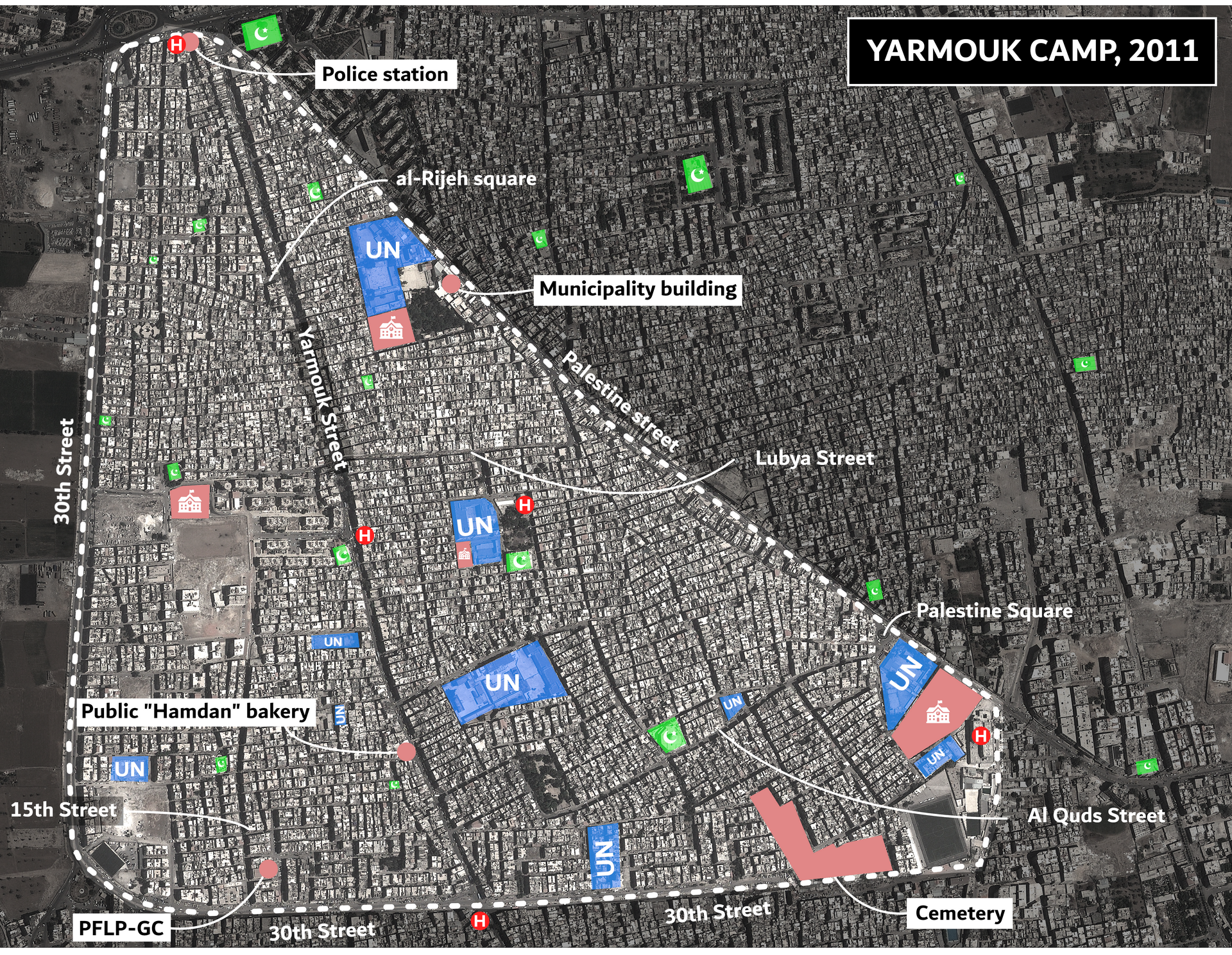
Before 2011: The Premises.
The Palestinian presence in Syria predates the Assad dictatorship. The influx of refugees in 1948 occurred under the presidency of Shukri Al-Quwatli, two years after Syria had gained its independence. At that time, there were 85,000 Palestinian refugees on Syrian territory, but several successive waves would occur in 1967 from the Golan Heights following the Six-Day War, in 1970 from Jordan following the events of Black September, and in 1982 from Lebanon due to the Lebanese civil war. In 2011, there were 585,610 Palestinian refugees in Syria.
Initially involved with the Palestinians in the Six-Day War and at the beginning of the 1970 crisis (Black September), Syria quickly betrayed their cause under Hafez al-Assad. Its participation in the Yom Kippur offensive in 1973 was aimed more at recovering the Golan Heights lost in 1967 than at defending the Palestinian cause. And as in 1967 and 1970, the Syrian armed forces were defeated, killing hundreds of Palestinian fighters from the Palestine Liberation Army, who were used to serve the interests of the dictatorship. The Golan Heights were left to Israel as part of the disengagement agreements signed between the two countries in 1974.
On January 20, 1976, Syria’s Palestinian proxies, the Palestine Liberation Army and As-Sa’iqa, massacred more than 500 Christian civilians in Damour, bringing shame on the Palestinian resistance, then embodied by the Palestine Liberation Organization (PLO), and prompting Christian militias to call on Syria for help. A little over four months later, Assad sent his army into Lebanon in an incomprehensible strategy aimed at supporting the Christian Phalangists against the “Palestinian progressives” of the PLO led by Yasser Arafat and the Lebanese National Movement led by Druze leader Kamal Jumblatt, thereby claiming to prevent Israeli intervention in Lebanon. Immediately after entering Lebanese territory, and after being stopped by the PLO in the Chouf, the Syrian army besieged the Palestinian camp of Tel al-Zaatar with the help of 3,000 Christian Phalangists. After a two-month siege, the Palestinian resistance surrendered and Assad allowed the Christian (fascist) militias to enter the camp on August 12, 1976. The militias proceeded to loot and burn homes, as well as rape and systematically massacre Palestinian civilians, executing more than 1,500 camp residents in one of the largest massacres of Palestinians since the Nakba.
From then until its withdrawal from Lebanon in April 2005, the Syrian army and the Assad regime would determine the fate of Lebanon, but also of the Palestinians in Lebanon and Syria. Following the Israeli intervention in Lebanon in 1982, the Syrian regime first allowed Iran to create, train, and arm Hezbollah and Islamic Jihad, using its territory as a bridge between Iraq and Lebanon, before using Iranian militias as proxies in its bloody war against all Syrians from 2011 onwards, whether they were progressives or Islamists. At the same time, the PLO was expelled from Lebanon, marking the end of political freedom for Palestinians in Lebanon, whose situation became aligned with that of Palestinians in Syria. Treated as eternal foreigners and deprived of their civil rights, they were condemned to neutrality and economic dependence, while being dispossessed of their struggle for the liberation of Palestine, which was taken over by the Syrian state, the Iranian state, and their proxies, with Syria itself soon becoming Iran’s proxy, after having been that of Soviet Russia.
Now that we have set the context, let us turn to the recent history of Yarmouk.
2011–2012: Turmoil. Pro-Assad militias and the regime’s first bombs.
When the uprising broke out in March 2011, the residents of Yarmouk and its political factions initially maintained the position of neutrality that had been imposed on them for nearly 30 years. After an initial strike—which was violently suppressed—to protest the bombing of the Palestinian refugee camp in Dera’a in April, tensions gradually increased between June 2011 and July 2012.
On the occasion of the commemoration of the Nakba and the Naksa, the regime organized two demonstrations on the Golan border on May 15 and June 5, 2011, through the PFLP-GC, during which 26 young Palestinians from Yarmouk were killed by the Israeli army while trying to cross the security barriers. During the funerals held in Yarmouk on June 6, Assad was accused by Yarmouk residents of trying to divert attention from his crimes against Syrians, as well as from the controversial statements made by his cousin and key regime businessman Rami Makhlouf, who had just claimed that “the security of the Syrian regime was one with that of Israel.” The PFLP-GC, for its part, was held responsible for the tragic events that occurred on the Golan border, and in particular for sending the demonstrators into a trap after galvanizing and manipulating them to serve the regime’s false pro-Palestinian propaganda. The regime claimed that attacking it was tantamount to attacking the “Axis of Resistance” and serving the interests of American imperialism and Zionism. Consequently, the Syrian rebellion was equated with a Zionist conspiracy, and Syrian protesters and rebels were portrayed as agents of Western imperialism. Unfortunately, a large part of the Palestinian solidarity movement and the Western Left fell for this specious argument and continue to this day to support the Assad regime and its allies [1]. In any case, the Palestinians of Yarmouk were not deceived, and the funeral, which brought together 30,000 people, turned into a demonstration and surrounded the PFLP-GC headquarters “Al-Khalsa” located on the southern edge of Yarmouk. The guards opened fire, killing two protesters: Rami Siyam (14) and Jamal Ghutan. Hundreds of protesters then stormed the building and set it on fire, killing two members of the PFLP-GC before being repelled by regime forces and PFLP-GC reinforcements.
In August 2011, the regime bombed the Al-Ramel Palestinian refugee camp on the outskirts of Latakia, accusing its residents of supporting “terrorism” due to the strong anti-Assad activity in the camp. More than half of its 10,000 residents were forced to flee the camp by regime forces and their shabiha, who proceeded to loot their homes. In the wake of this, Yarmouk organized its first demonstration in solidarity with Al-Ramel on August 17, 2011, bringing together around 300 people. During the summer, nearly 70,000 displaced persons from various cities targeted by the regime were welcomed en masse into the mosques, schools, and public spaces of Yarmouk.
During 2012, demonstrations and strikes multiplied, echoing the main slogans of the Syrian revolution, while the army opened fire on the crowd and broke the locks of striking businesses to force them to resume their activities. The regime’s security services began to express concern about these protest movements, urging community leaders to silence them.
It should be noted that before the summer of 2012, Yasser Qashlak, a Palestinian millionaire loyal to the regime and founder and leader of the Free Palestine Movement, formed the “Al-Aqsa Shield Forces ” (Quwaat Der’a Al-Aqsa), a group of mercenaries tasked with deterring the opposition from gathering, in particular by meeting at the exits of mosques and staging pro-regime demonstrations. At the end of the summer, Qashlak also financed the arming of 1,100 members of the armed wing of the PFLP-GC, the Jibril Jihad Brigades (Kataeb Jihad Jibril), 500 of whom went on to form the Popular Committees (Al-Lijan al-Sha’biyah), militias set up in Yarmouk and in various districts of the Damascus region to prevent the infiltration of Sunni rebel groups and thus counter the predictable offensive of the Free Syrian Army[2].
On July 13, 2012, Yarmouk was the starting point for a demonstration of several thousand people heading to the neighboring district of Tadamon to protest against its bombing, but also against the massacre of more than 150 civilians in Tremseh (Hama) by Assad’s shabiha and the death of Palestinian recruits in the war waged by the regime against its people. Once again, the army opened fire on the demonstration and killed 10 protesters.
The next day, the funeral, attended by 50,000 people, led to the encirclement of Yarmouk by armored vehicles, and the foreign minister threatened the Palestinian refugees, declaring that as guests they were subject to a duty of neutrality. This desire for neutrality was widely shared by residents and all Palestinian factions, who knew what dramatic consequences opening a new front with the regime in Yarmouk could bring.
[1] Read our publication “Western leftist comrades, you failed your Levantine fellows,” available at https://interstices-fajawat.org/western-leftist-comrades-you-failed-your-arab-fellows/
[2] Tom Rollins, Palestinian-Syrian Militarization in Yarmouk, Atlantic Council, July 19, 2017, available at https://www.atlanticcouncil.org/blogs/syriasource/palestinian-syrian-militarization-in-yarmouk/
2012–2013: The Explosion. The armed rebellion takes control of Yarmouk.
In July 2012, the Free Syrian Army launched its “Damascus Volcano” offensive to liberate the capital. On July 15, the police station at the entrance of Yarmouk was attacked and set on fire, prompting an air strike by the regime and the first strikes on the camp on July 17, killing nine people. Three days later, the FSA withdrew and the regime’s army regained control of all the areas bordering the camp (Al-Hajar al-Aswad, Tadamon, Qadam), forcing many of its inhabitants to take refuge in Yarmouk in addition to the thousands of displaced persons already there.
During the summer, the Yarmouk camp took in thousands more displaced persons, while the regime continued its massive bombardment of Syrian cities in response to the Free Syrian Army rebellion. As a result of this massive influx of displaced persons, the population reached nearly 900,000, three times more than before the uprising. On August 2, 2012, a regime strike killed 21 people in what became known as the “Ja’ouneh Street massacre.” Yarmouk then entered the civil war for the first time, seeing the spread of a “call to protect the Palestinian camps” during the fall, followed by the establishment of Palestinian armed factions opposed to the regime: Aknaf Beit al-Maqdis (affiliated with Hamas and led by Abu Ahmed Mushir), Liwa al-Asifa, Ababil Falastin, Liwa Al-‘Ahda Al-‘Umariya…
Map No. 3: Yarmouk – Situation after the FSA offensive, late 2012.
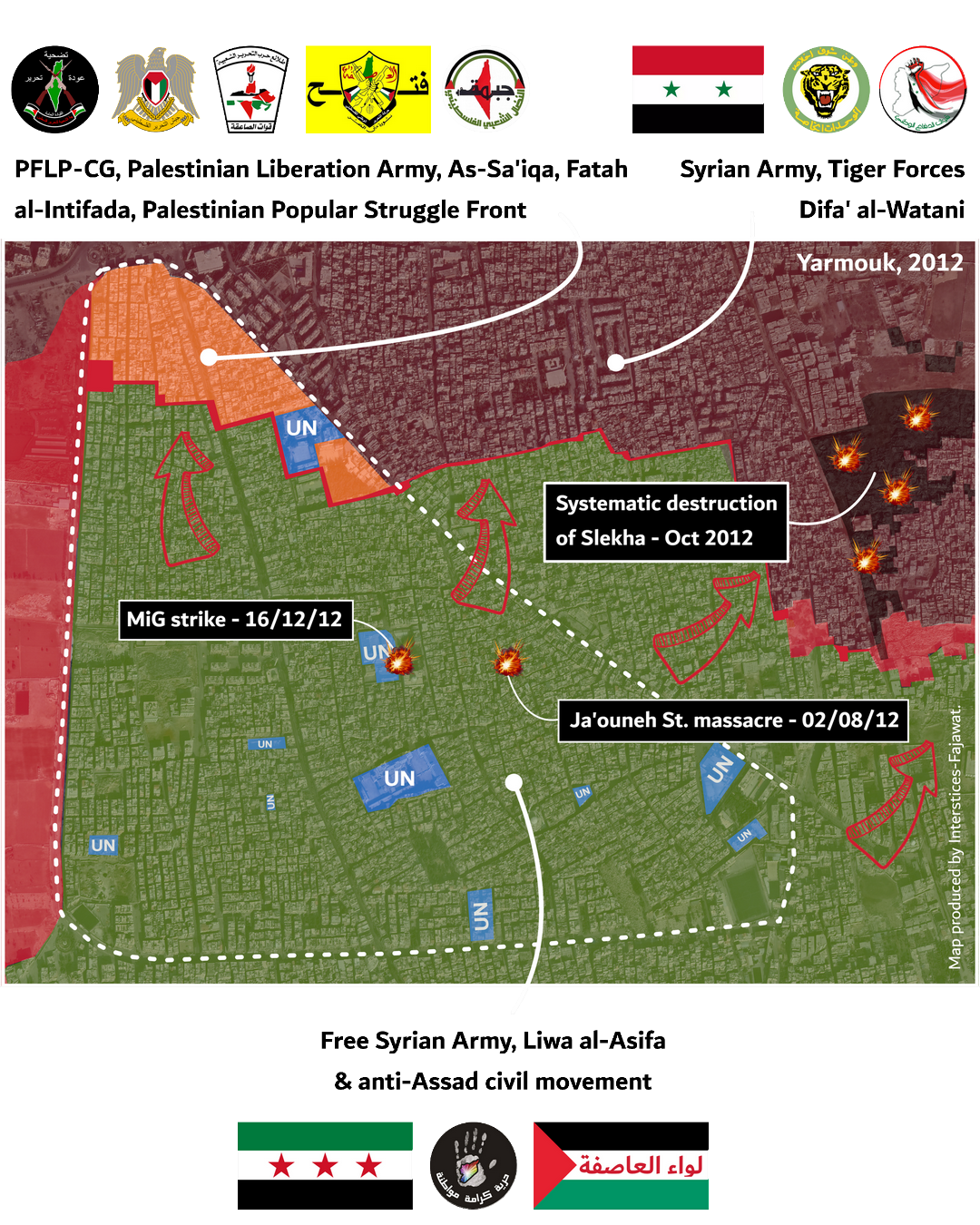
Hamas, which had supported the protests against the regime, was now offering its expertise to the rebels of the Free Syrian Army and Aknaf Beit al-Maqdis without publicly admitting it. This dangerous choice was motivated by the rise to power of Mohamed Morsi and the Muslim Brotherhood—their patrons and sponsors—in Egypt, but it would very quickly lead to retaliation by the Syrian regime with the arrest and torture of Mamoun al-Jaloudi, commander-in-chief and bodyguard of Hamas Political Bureau Chief Khaled Meshaal, followed by the expulsion of Meshaal and other Hamas leaders from Damascus to Qatar, Cairo, and Gaza. [1] [2] It was also during this period that Jabhat al-Nusra began operating in the district alongside the FSA.
While the regime continued its daily bombardments since the summer, the escalation reached a breaking point in December when Palestinian militias loyal to the regime began to establish checkpoints around Yarmouk and to confront the Free Syrian Army militarily in al-Hajar al-Aswad and Yalda, where the latter had now established itself. It should be noted that the PFLP-GC had so far only used its weapons to intimidate and persecute camp residents, without ever confronting the armed opposition.
Starting on December 12, 2012, the regime initially banned trucks carrying materials from entering the camp. The next day, a strike targeted Al-Bassel Hospital, and then, on December 16, 2012, another air strike targeted the Abd Al-Qader Al-Hussaini mosque and the adjacent school, which were sheltering several hundred refugees from neighboring neighborhoods, killing 200 people in what was called the “MiG massacre” or “Abdul Qader Al-Hussaini massacre.” [3]
The very next day, hundreds of Free Syrian Army and Jabhat al-Nusra fighters took possession of Yarmouk, pushing the PFLP-GC and its allies to the northern end of the camp and declaring it a “liberated zone.” The regime then bombarded the camp heavily, forcing 80% of its residents, both Palestinians and internally displaced persons, to flee Yarmouk to Qudseya and Sehnaya. [4] The factions affiliated with the FSA at the time were Suqur Al-Joulan, Ababil Hawran, Jund Allah, Saraya al-Beyt, Ahfad Aisha, Abu Al-Harith Joulani, Imam Thahabi, Shuhada Al-Nour, and others.
The Suqur al-Joulan and Ababil Hauran factions began looting the homes of residents who refused to leave Yarmouk while squatting with their families in empty homes, creating tensions between residents and the factions present, while Jabhat al-Nusra gradually established Islamic law and persecuted Palestinian activists.
[1] Mohanad Hage Ali, Kill List, Carnegie Middle East Center, 14 mai 2018, accessible à https://carnegieendowment.org/middle-east/diwan/2018/05/kill-list?lang=en
[2] Mamoon Alabbasi, How did Hamas’s military expertise end up with Syria’s rebels?, Middle East Eye, 23 mai 2015, accessible à https://www.middleeasteye.net/news/how-did-hamass-military-expertise-end-syrias-rebels
[3] Action Group For Palestinians in Syria, 9 Years On, Palestinians of Syria Remember Tragic ‘Mig Massacre’ in Yarmouk Camp, 16 décembre 2022, accessible à https://www.actionpal.org.uk/en/post/13709/articles/9-years-on-palestinians-of-syria-remember-tragic-mig-massacre-in-yarmouk-camp
[4] Al-Arabiya, (ARABE) The Military Council of the Free Army storms the Yarmouk camp, 17 Décembre 2012, accessible àhttps://www.alarabiya.net/articles/2012/12/17/255640
Map No. 5: Yarmouk – Areas of influence in mid-2013
Year 1 of the siege
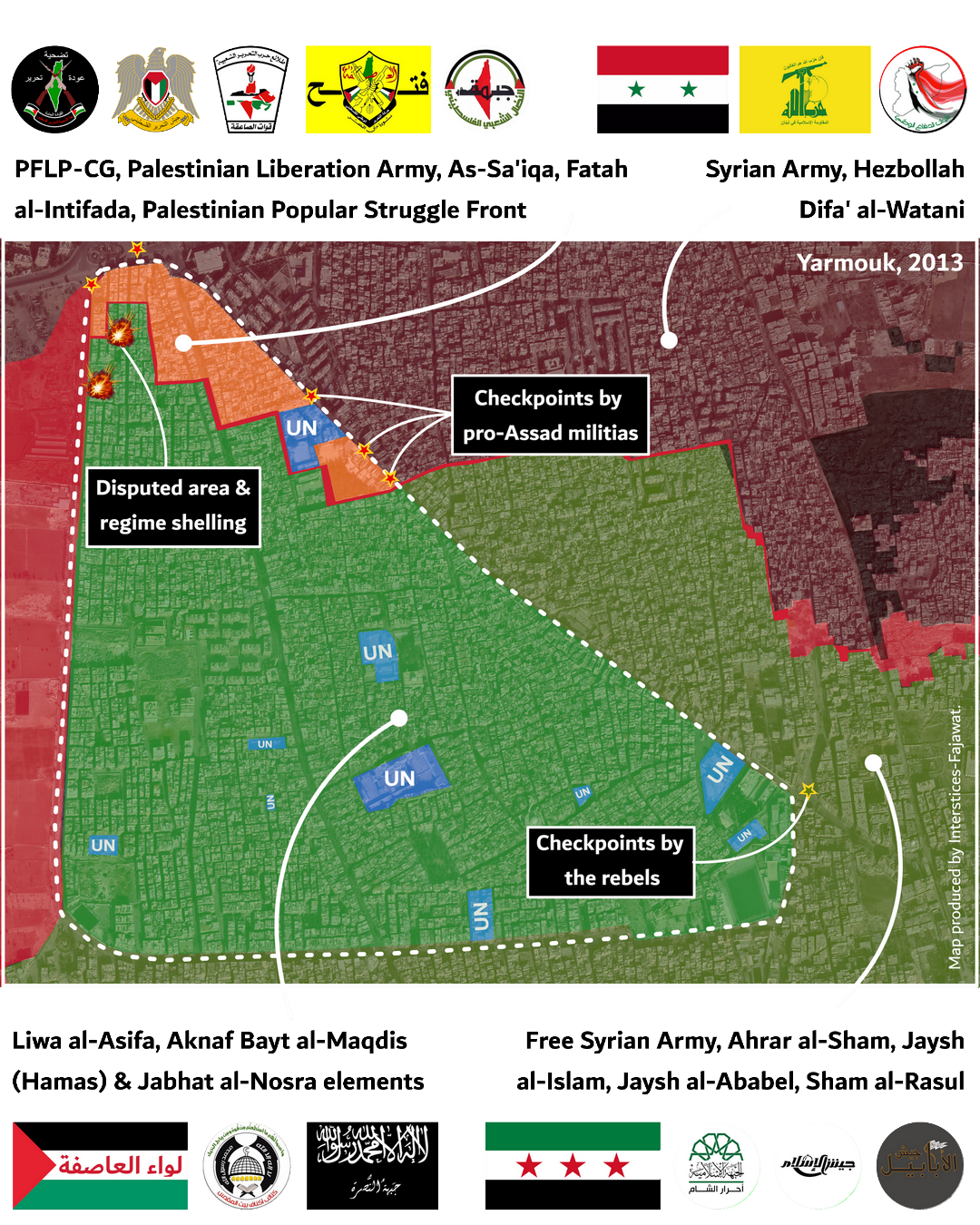
Map No. 6: Yarmouk – Areas of influence in mid-2014
Year 2 of the siege
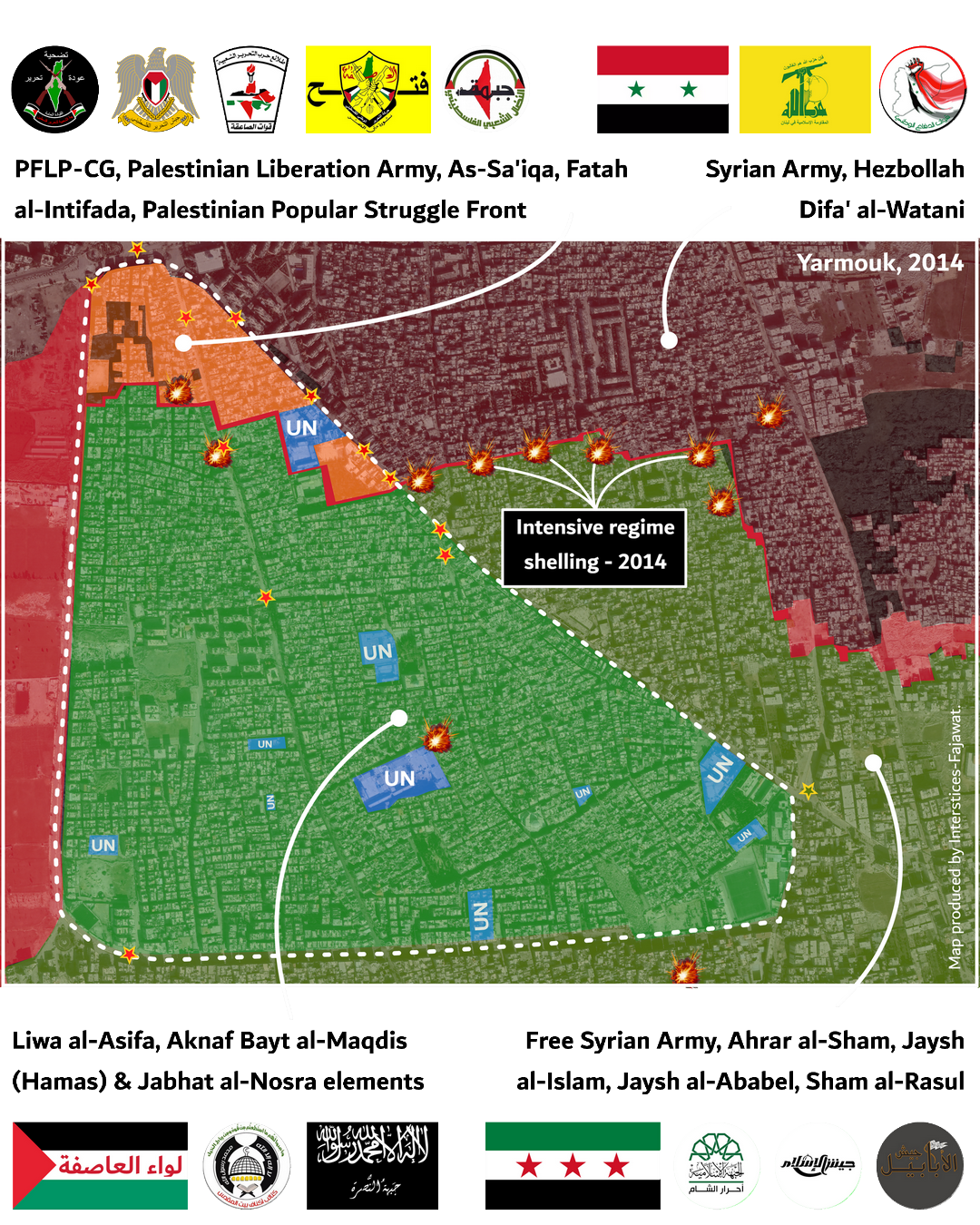
2015–2016: The Overwhelming Force. Takfiris rush into Yarmouk
On January 15, 2015, activists launched an appeal for help “Save the Palestinians of Syria,” demanding that the PLO, the UN, and the Red Crescent assume their responsibilities and intervene to end the 546-day siege imposed on the residents of Yarmouk, or at the very least secure the opening of a humanitarian corridor allowing civilians who wish to do so to leave the various camps besieged by the regime. [1] [2] At the same time, new skirmishes between the PFLP-GC and Aknaf Beit al-Maqdis between Palestine Street and Al-Rijeh Square once again led to the suspension of humanitarian aid, with civilians regularly being targeted by snipers. [3] [4]
On January 19, seven brigades affiliated with the FSA (Jaysh al-Islam, Ajnad al-Sham, Ahrar al-Sham, Aknaf Beit al-Maqdis, Quwaat al-Islah, Al-Hahy’a Al-Shara’iya Fiy Janub Dimashq, Muqatilu Al-Hajar Al-Aswad, etc.) issued a statement threatening the regime with a large-scale military response if it invaded the Yarmouk camp, as suggested by statements in the Lebanese press referring to the establishment of a brigade for this purpose, “Al-Yarmouk Brigade.” [5]
On January 26, Jabhat Al-Nusra executed a third resident of the camp accused of “blasphemy.” [6]
At the end of January, the children of Yarmouk organized a demonstration in front of the Youth Support Center under the banner “A Child’s Cry” to call for the lifting of the siege, while Fatah was criticized for organizing its movement’s anniversary in a restaurant a few kilometers from Yarmouk and more than a hundred camp residents were affected by an epidemic of jaundice. [7]
On March 11, 2015, the regime allowed a humanitarian convoy led by UNRWA chief Pierre Krahenbuhl to enter the camp after more than three months of interruption. [8] [9]
On March 30, 2015, Hamas leader Yahya Hourani (Abu Suhaib) was killed by a sniper, leading to the arrest of IS members by Aknaf Beit al-Maqdis. This event was the trigger for IS’s attack on Yarmouk the following day, during which a thousand IS fighters seized the camp from Al-Hajar al-Aswad with the help of Jabhat al-Nosra, which handed over the areas under its control. Three hundred Jabhat al-Nusra fighters had in fact broken their alliance with Aknaf Beit al-Maqdis and joined IS. [10] [11]
After a failed first assault on April 1, 2015, during which IS besieged the Diaspora Office (Maktab al-Shatat) held by Aknaf Beit al-Maqdis, the confrontation continued for two days along Nouh Ibrahim and ‘Atta az-Zeer streets, where IS faced both Aknaf Beit al-Maqdis and Jaysh al-Islam. ISIS finally seized 90% of the camp on April 4, prompting the regime to use 13 barrel bombs in a few days, whereas only two barrel bombs had been used on Yarmouk since the start of hostilities. Aknaf Beit al-Maqdis was then cornered on a narrow strip in the center of the camp, while the PFLP-GC and Fatah al-Intifada took advantage of this to seize the perimeter between the Municipality district and the Rujula mosque. [12] [13]
On April 6, 2015, Aknaf Beit al-Maqdis regrouped its forces in the south of the camp and launched an assault against ISIS, temporarily recapturing the Cultural Center area, Morocco Street, Al-Ja’ouneh Street, and the Martyrs’ Cemetery, momentarily controlling 40% of the camp. [14]
On April 7, 2015, a ceasefire was agreed, with ISIS ultimately controlling 95% of the camp. During the assault, five civilians were killed in the clashes, three were killed by shelling, two were beheaded by ISIS, and an eleventh was killed by an ISIS sniper. For its part, IS lost 40 of its fighters.
On April 8, 2015, 14 Palestinian factions met to attempt an alliance with regime forces against IS, but only the pro-Assad factions agreed to join forces with the regime.
On April 12, 2015, the Free Syrian Army and Jaysh al-Islam launched an offensive against ISIS and recaptured Al-Zeen Street between Yalda and Al-Hajar al-Aswad, but did not venture into Yarmouk, while Ahrar al-Sham remained entirely neutral towards ISIS.
On April 19, 2015, most of Jabhat al-Nosra’s fighters had joined ISIS, and Aknaf Beit al-Maqdis announced its dissolution, with some of its fighters joining the regime and others joining Jabhat al-Nosra, while a minority took refuge in the Yalda area controlled by the Free Syrian Army. In ten days of fighting, the regime dropped some 30 barrel bombs on Yarmouk, causing unprecedented damage to the camp and forcing 4,000 of its residents to flee to areas controlled by the FSA in Yalda (2,500), Babbila (1,000), and Beit Sahem (500). At the end of the fighting, IS controlled 80% of the camp and 23 Palestinian refugees had been killed since the beginning of the month. [15] [16] [17]
On April 22, 2015, ISIS withdrew to its stronghold in Al-Hajar al-Aswad and left the management of the camp to Jabhat al-Nusra and Ahrar al-Sham. [18] In reality, the border between IS and Jabhat al-Nusra was extremely porous, and there was no clear way to distinguish between militants from one group and the other. In June 2015, around 75 children aged between 7 and 13 were recruited by Jabhat al-Nusra and trained in combat by IS in Al-Hajar al-Aswad before being used as foot soldiers for various military tasks, including observing enemy movements from checkpoints and carrying out suicide operations. [19]
On December 25, 2015, an initial agreement was signed between the regime and ISIS providing for the evacuation of its wounded fighters from the neighboring district of Al-Qadam to other regions of Syria. [20]
By the end of 2015, only 14,000 residents remained in Yarmouk, while a typhus epidemic was spreading throughout the camp.
[1] Action Group for Palestinians in Syria, Palestinian Activists Launch a Campaign Titled #Save_Palestinians_of_Syria, 15 Janvier 2015, accessible à http://actionpal.org.uk/en/post/254/action-group-for-palestinians-of-syria/palestinian-activists-launch-a-campaign-titled-save-palestinians-of-syria
[2] Action Group for Palestinians in Syria, Civil Committees at the Yarmouk Camp Launch a Distress Call, After the Siege Victims Number Raised to (160), 15 Janvier 2015, accessible à http://actionpal.org.uk/en/post/257/action-group-for-palestinians-of-syria/civil-committees-at-the-yarmouk-camp-launch-a-distress-call-after-the-siege-victims-number-raised-to-160
[3] Action Group for Palestinians in Syria, Shooting and Recriminations Causing Aids Suspension at the Besieged Yarmouk, 11 Janvier 2015, accessible à http://actionpal.org.uk/en/post/226/action-group-for-palestinians-of-syria/shooting-and-recriminations-causing-aids-suspension-at-the-besieged-yarmouk
[4] Action Group for Palestinians in Syria, Violent Clashes Suspend Aids Distribution at the Yarmouk Camp, 18 Janvier 2015, accessible à http://actionpal.org.uk/en/post/278/action-group-for-palestinians-of-syria/violent-clashes-suspend-aids-distribution-at-the-yarmouk-camp
[5] Action Group for Palestinians in Syria, Armed Brigades Threaten to Ignite the Southern Region in Case of Breaking Into the Yarmouk Camp, 19 Janvier 2015, accessible à http://actionpal.org.uk/en/post/285/action-group-for-palestinians-of-syria/armed-brigades-threaten-to-ignite-the-southern-region-in-case-of-breaking-into-the-yarmouk-camp
[6] Action Group for Palestinians in Syria, Al Nusra Front Executes a Young Man in the Yarmouk Camp in Charges of Cursing the Name of God, 26 Janvier 2015, accessible à http://actionpal.org.uk/en/post/340/action-group-for-palestinians-of-syria/al-nusra-front-executes-a-young-man-in-the-yarmouk-camp-in-charges-of-cursing-the-name-of-god
[7] Action Group for Palestinians in Syria, “A Child’s Scream” a Protest for the Yarmouk Children to take the Siege Away, 30 Janvier 2015, accessible à http://actionpal.org.uk/en/post/371/action-group-for-palestinians-of-syria/a-child-s-scream-a-protest-for-the-yarmouk-children-to-take-the-siege-away
[8] Action Group for Palestinians in Syria, The Civil Council in the Yarmouk Camp Demands the PLO to assume its responsibilities towards the camp, 3 Janvier 2015, accessible à http://actionpal.org.uk/en/post/161/action-group-for-palestinians-of-syria/the-civil-council-in-the-yarmouk-camp-demands-the-plo-to-assume-its-responsibilities-towards-the-camp
[9] Middle East Eye, Aid convoy enters Damascus camp for first time in months, 11 Mars 2015, accessible à https://www.middleeasteye.net/news/aid-convoy-enters-damascus-camp-first-time-months
[10] Valentina Napolitano, Yarmouk: a War of All Against All, Noria Research, 28 Mai 2015, accessible à https://noria-research.com/yarmouk-a-war-of-all-against-all/
[11] The Syrian Observer, Aknaf Commander: Nusra Front, Regime Complicit in ISIS Capture of Yarmouk, Zaman al-Wasl, 8 Avril 2015, accessible à https://syrianobserver.com/syrian-actors/aknaf_commander_nusra_front_regime_complicit_isis_capture_yarmouk.html
[12] Middle East Eye, IS takes control of 90 percent of Yarmouk, called ‘hell hole’ by UN official, 4 Avril 2015, accessible à https://www.middleeasteye.net/news/takes-control-90-percent-yarmouk-called-hell-hole-un-official
[13] Hanadi Al-Khatib, (ARABE) ISIS releases video on Yarmouk camp, the endless victim, Al-Arabiya, 28 Avril 2015, accessible à https://shorturl.at/BUSy8
[14] Tariq Hammoud, Situation Assessment: Yarmouk Refugee Camp: What Happens Next?, Al-Zaytuna Centre for Studies & Consultations, 25 Mai 2015, accessible à https://eng.alzaytouna.net/2015/05/25/situation-assessment-yarmouk-refugee-camp-what-happens-next/
[15] Ramzy Baroud, My missing family in Syria: Naming and shaming in Yarmouk, Middle East Eye, 13 Avril 2015, accessible à https://www.middleeasteye.net/opinion/my-missing-family-syria-naming-and-shaming-yarmouk
[16] Linah Alsaafin, Unravelling the media spin on Yarmouk, Middle East Eye, 17 Avril 2015, accessible à https://www.middleeasteye.net/news/unravelling-media-spin-yarmouk
[17] Abdulrahman al-Masri, ‘ISIS and Nusra are one’ in Yarmouk Camp, Middle East Monitor, 19 Avril 2015, accessible à https://www.middleeastmonitor.com/20150419-isis-and-nusra-are-one-in-yarmouk-camp/
[18] Hamza Al-Mustafa, Yarmouk: the victim of IS-Nusra power struggles, The New Arab, 22 Avril 2015, accessible à https://www.newarab.com/opinion/yarmouk-victim-nusra-power-struggles
[19] Palestine Square, Lost Childhood: Palestinian Child Soldiers in Yarmouk, Institute for Palestine Studies, 21 Septembre 2015, accessible à https://www.palestine-studies.org/en/node/232371
[20] Kate Ng, Syria and Isis reach deal to end Yarmouk camp siege, as wounded militants begin safe passage back to strongholds, The Independent, 25 Décembre 2015, accessible à https://www.independent.co.uk/news/world/middle-east/syria-and-isis-reach-deal-to-end-yarmouk-camp-siege-as-wounded-militants-begin-safe-passage-back-to-strongholds-a6786031.html
Map No. 7: Yarmouk – Areas of influence at the beginning of 2015

Map No. 8: Yarmouk – Offensive by Islamic State and Jabhat al-Nusra, April 2015
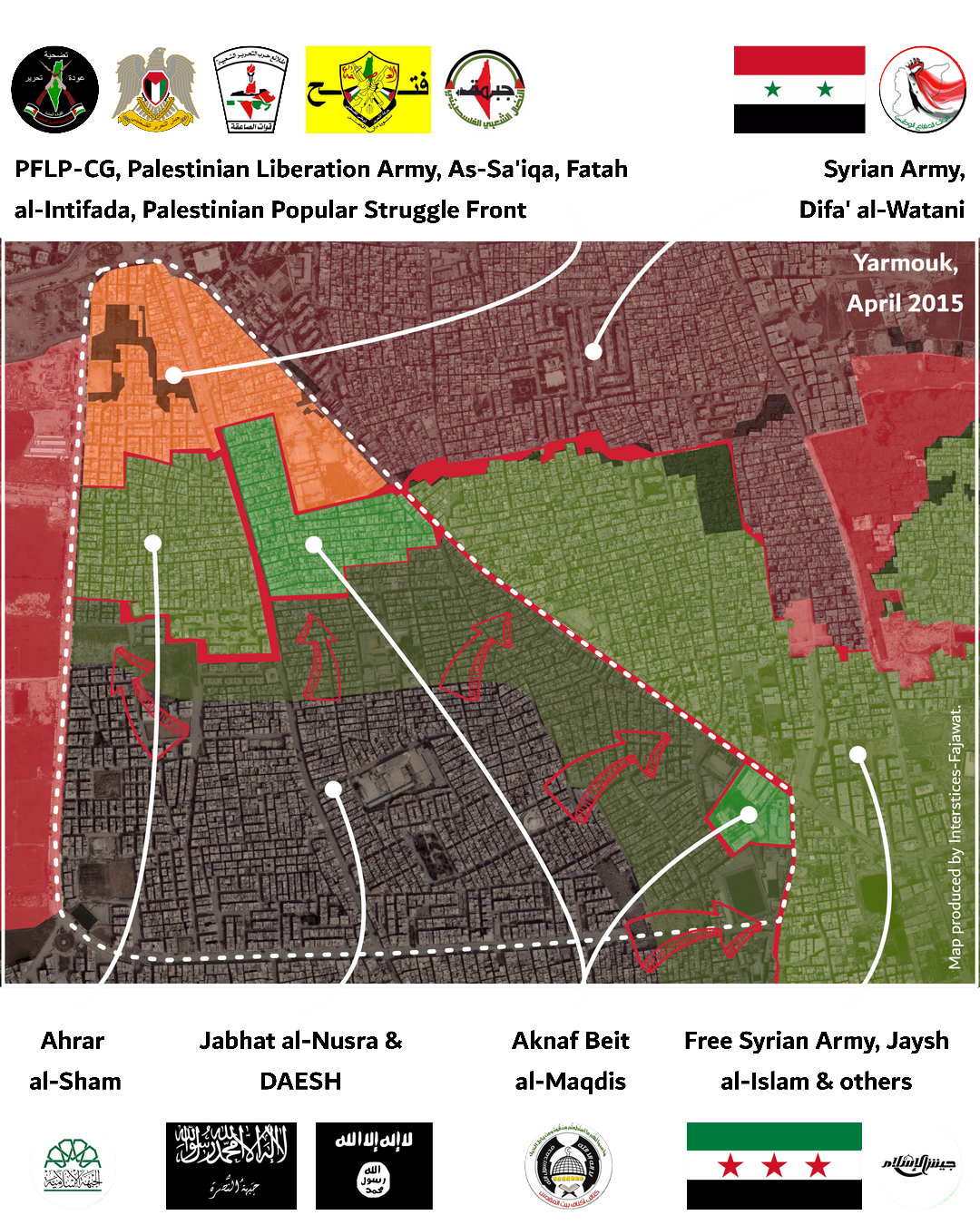
2016–2018: Decay. Birds of prey fight over the carcass.
In January 2016, relations between IS and Jabhat al-Nosra began to deteriorate. The latter was then confined to the western part of the camp, between 30th Street and Saffouriyeh Street.
In 2016, the millionaire Qashlak signed an agreement with Fatah al-Intifada for the “Free Palestine Movement” to gain control of a segment of the front line managed by the latter, in exchange for a substantial sum of money. He hoped to increase the symbolic power of his mercenaries, who were now on the front line in the fight against IS.
On July 8, 2016, the regime began negotiations with Jabhat al-Nusra with a view to evacuating it from Yarmouk to Idlib. At the end of the month, Jabhat al-Nusra changed its name to Fatah al-Sham.
In the following months, IS laid siege to Fatah al-Sham and issued an ultimatum to residents of the area under its control, ordering them to leave before it was completely sealed off. At the same time, IS evacuated the area around Al-‘Urubeh Street between Yalda and al-Hajar al-Aswad during clashes with the FSA and Jaysh al-Islam. [1]
ISIS thus transformed Yarmouk into a fortified camp, while paranoia increased on both sides. On December 4, 2016, Fatah al-Sham executed Mohamed Aboud, known as “Abu Ali Khamseen,” accused of collaborating with ISIS.
By the end of 2016, an additional 6,250 residents had fled Yarmouk.
In January 2017, Fatah al-Sham became Hayat Tahrir al-Sham (HTS).
On May 8, 2017, around 50 HTS members, including 19 wounded, were evacuated by ambulance and bus to Idlib as part of the “Four Cities Agreement” initiated the previous year between the group and the regime. Three months later, the regime established a “new military zone” along its front with HTS, leading to the evacuation of several families and the conversion of their homes into military positions, while a Syrian Red Crescent mission escorted by the PFLP-GC was allowed to enter the HTS-held area on September 7. In addition, a truce was then in effect between the regime and IS. [2] [3]
On September 14, 2017, ISIS imposed a new siege on residents living in the HTS-controlled sector, which at the time had around 200 fighters, before launching an assault on Jaysh al-Islam and FSA factions (Liwa Sham al-Rasul, Jaysh al-Ababil, Kataeb al-Shuhada al-Islam, and the Islamic Union Ajnad al-Sham) south of Yarmouk, capturing the area where the hospital was under construction. At the same time, Jaysh al-Islam and the FSA signed a truce with the regime as part of the “de-escalation” agreements adopted in Cairo under the auspices of Egypt and Russia, which came into force on October 12. The next day, the regime resumed a series of airstrikes against IS positions in Al-Hajar al-Aswad, followed by skirmishes between Jaysh al-Islam and IS at the ‘Urubeh-Beirut checkpoint between Yalda and Yarmouk. [4] [5]
On November 11, 2017, the regime threatened the FSA with closing the Babbila-Sidi Miqdad checkpoint, the only link between the areas under regime control and the area under FSA control, if the FSA did not close the checkpoint Urubeh-Beirut was the only access point to the Yarmouk camp, which the rebels had reopened on November 4 but which could only be used by 10 to 15% of the population of Yarmouk, estimated at less than 8,000 people at the time. The FSA therefore temporarily closed access to the area controlled by ISIS, but reopened it in the following hours under pressure from Yarmouk residents who had taken refuge in Yalda. In response, the regime carried out its threats and closed the Babbila-Sidi Miqdad checkpoint on November 12, causing prices in the enclave to rise by 20%. It was not reopened until two months later. [6] [7]
On December 8, 2017, pro-regime militias launched an attack to recapture the Al-Rijeh district under HTS control, but to no avail. That same month, ISIS secured the signing of an initial agreement for the evacuation of 19 of its wounded fighters to the desert and Turkey, in exchange for easing the siege imposed on the district under HTS control to allow food to enter. [8] [9]
On December 13, ISIS launched an attack in Tadamon and seized a block of buildings controlled by the pro-regime militia Difa’a al-Watani for the first time since 2015, before the latter recaptured it and bombed Yarmouk for several weeks in retaliation. [10]
By the end of 2017, only 6,000 residents remained in Yarmouk.
[1] Action Group for Palestinians in Syria, ISIS evacuates one of Yarmouk Streets from its Residents and starts Violent Clashes with the Opposition, 16 Août 2016, accessible à https://www.actionpal.org.uk/en/post/3762/news-and-reports/isis-evacuates-one-of-yarmouk-streets-from-its-residents-and-starts-violent-clashes-with-the-opposition
[2] Al-Jazeera, Deal sees Nusra fighters evacuate from Syria’s Yarmouk, 7 Mai 2017, accessible à https://www.aljazeera.com/news/2017/5/7/deal-sees-nusra-fighters-evacuate-from-syrias-yarmouk
[3] Zaman Al-Wasl, Wounded Nusra fighters evacuated from Yarmouk camp, 8 Mai 2017, accessible à https://en.zamanalwsl.net/news/article/25955
[4] The New Arab, Syrian rebel groups ‘agree to Damascus truce’ in Cairo, 12 Octobre 2017, accessible à https://www.newarab.com/news/syrian-rebel-groups-agree-southern-damascus-truce
[5] Tom Rollins, Escalation Threatens South Damascus “De-Escalation” Deal, Atlantic Council, 27 Octobre 2017, accessible à https://www.atlanticcouncil.org/blogs/syriasource/escalation-threatens-south-damascus-de-escalation-deal/
[6] Ammar Hamou & Madeline Edwards, A ‘war of crossings’ in south Damascus as checkpoint closure cuts off encircled districts, Syria Direct, 13 Novembre 2017, accessible à https://syriadirect.org/a-war-of-crossings-in-south-damascus-as-checkpoint-closure-cuts-off-encircled-districts/
[7] Siege Watch, Ninth Quarterly Report on Besieged Areas in Syria, Janvier 2018, accessible à https://siegewatch.org/wp-content/uploads/2015/10/pax-tsi-siegewatch-9.pdf
[8] Zaman Al-Wasl, 19 ISIS fighters evacuated by regime from southern Damascus, some reached Turkey, 14 Décembre 2017, accessible à https://en.zamanalwsl.net/news/article/31704
[9] Action Group for Palestinians in Syria, ISIS allows the besieged residents of west Yarmouk camp to enter food, 29 Décembre 2017, accessible à https://www.actionpal.org.uk/en/post/6375/articles/isis-allows-the-besieged-residents-of-west-yarmouk-camp-to-enter-food
[10] Siege Watch, Ninth Quarterly Report on Besieged Areas in Syria, Janvier 2018, accessible à https://siegewatch.org/wp-content/uploads/2015/10/pax-tsi-siegewatch-9.pdf
Map No. 9: Yarmouk – Areas of influence between 2015 and 2016
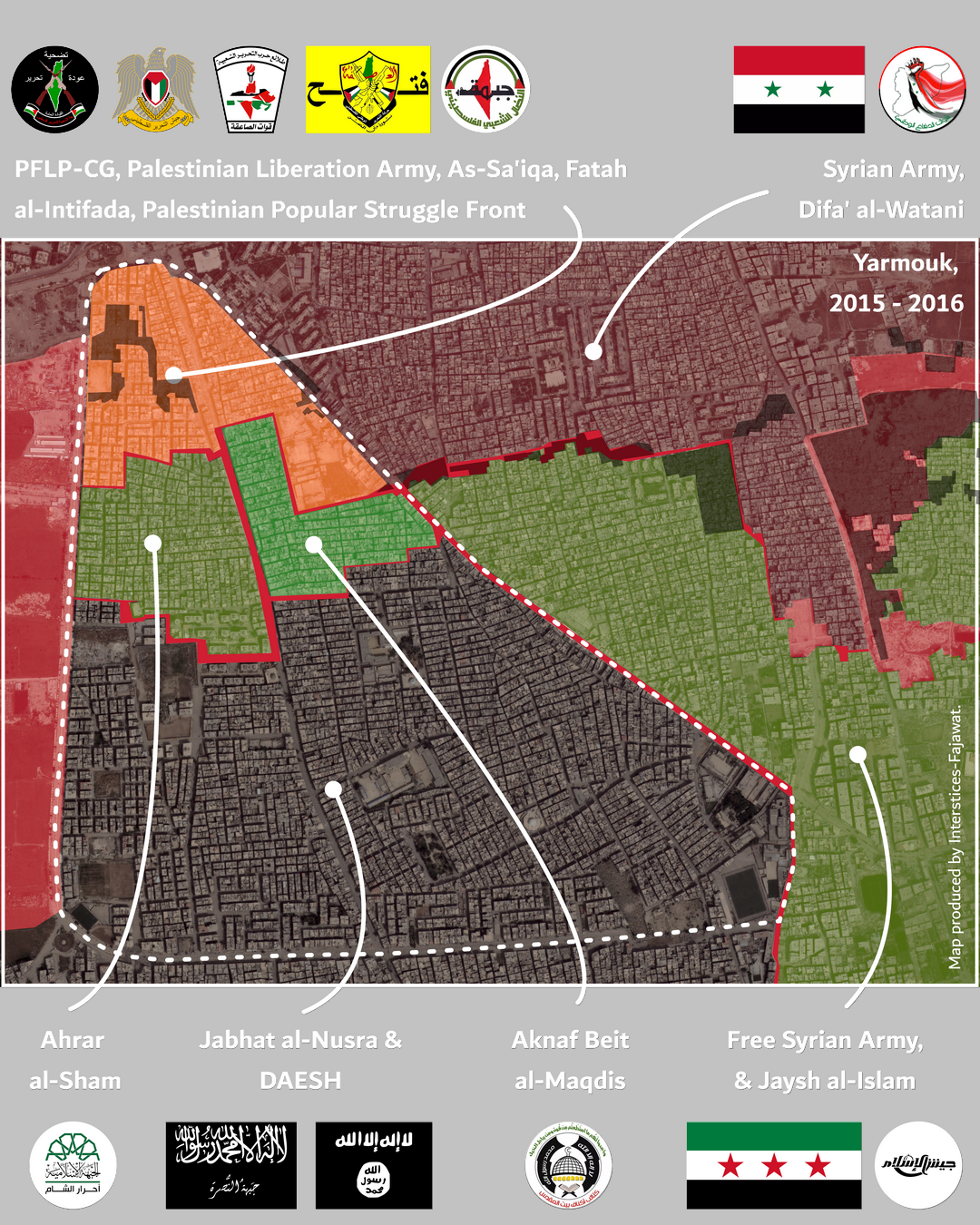
Map No. 10: Yarmouk – Areas of influence between 2016 and 2017
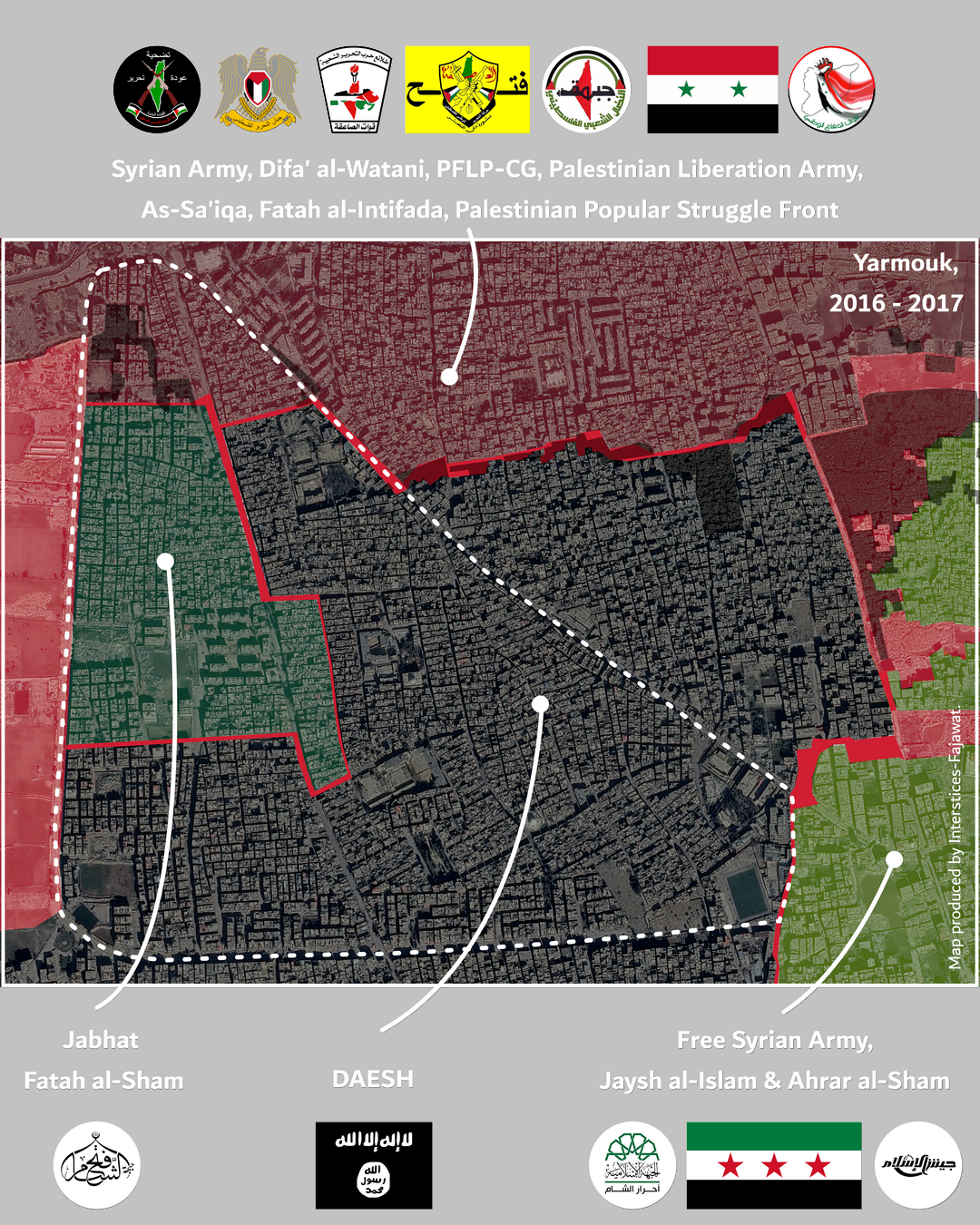
2018: Liquidation. The Islamists go for a bus ride.
On January 5, 2018, Jaysh al-Islam attempted a final offensive against ISIS from Yalda, without success.
Between 2016 and 2018, ISIS gradually imposed its totalitarianism and violence on the camp’s residents, banning the consumption or sale of cigarettes, breastfeeding, applause during weddings, ball games, photography, and the sale of wood for heating, while imposing strict dress codes for both women and men (length of trousers). IS also closed all schools within the camp (August 3, 2016) and prevented any school activities outside its control, while a curfew was imposed during prayer times, for which attendance at the mosque was mandatory. After finding that residents had circumvented the closure of schools in the camp, IS banned all students from attending alternative schools in adjacent towns (March 6, 2018), then forced all residents to attend Sharia law classes (April 16, 2018). Those who violated these rules were flogged, mutilated, or even executed: Musa al-Badawi, accused of being a spy for HTS (February 27, 2018); an unidentified man accused of insulting Allah (April 13, 2018); and Khaled Adnan Ahmed, accused of fighting alongside the regime (April 23, 2018).
In April, sensing increasing pressure from the regime, ISIS evacuated the Martyrs’ Cemetery neighborhood following clashes with the Free Palestine Movement in order to transform it into a military defense zone. [1] [2]
On April 19, 2018, the Syrian regime and its allies (PFLP-GC, Fatah al-Intifada, Liwa al-Quds, Difa’a Al-Watani, Jaysh At-Tahrir Al-Falasteen, Quwaat Der’a Al-Qalamun, etc.) launched a major offensive to recapture the outskirts of Damascus. This was accompanied by intensive and frenzied bombing of the Yarmouk, Tadamon, Hajar al-Aswad, and Yalda by the Russian air force (400 air strikes and the massive use of explosive barrels, mortar shells, and surface-to-surface missiles, including Russian UR-77 “Serpents Gorynysh” destroyers). 5,000 residents of Yarmouk fled to the Yalda-Babbila area, leaving fewer than 1,200 people behind. [3]
The next day, the air force violently struck Jaysh al-Islam positions between Yalda and Hajar al-Aswad, forcing it to withdraw from its front line with ISIS and allowing regime forces to move into the gap. At the same time, regime forces surrounded the camp and made several attempts to capture the area held by HTS with the support of heavy weapons and armored vehicles, but were held back. IS, for its part, fought fiercely on all fronts, against both HTS and regime forces and their allies. [4]
On April 27, a first group of 15 wounded Jaysh al-Islam fighters was evacuated to northern Syria as part of a transitional agreement with the regime, while negotiations continued for the complete evacuation of the area. At the same time, regime forces carried out 165 airstrikes on the area on the same day, burning down around 100 homes in Yarmouk and Tadamon.
On April 29, an agreement between the regime and HTS on the one hand, and the FSA on the other, provided for the imminent evacuation of HTS, Jaysh al-Islam, Aknaf Beit al-Maqdis, Sham al-Rasul, and Jaysh al-Ababil. The Uruba-Beirut checkpoint was transferred to Russian forces, while the Babbila-Sidi Miqdad checkpoint was partially reopened for civilians to pass through.
On May 1, 2018, the 150 HTS fighters and their families (425 people) were evacuated from Yarmouk first from the northern entrance of the camp, followed from May 3 to 7 by the 1,700 fighters from the FSA, Jaysh al-Islam, and Aknaf Beit al-Maqdis factions accompanied by their families (9,250 people out of the 17,000 planned), evacuated from Yalda, Babbila, and Beit Sahem to Al-Bab (Idlib) in seven convoys of 61 buses in total. In parallel with these evacuation operations, the regime continued its intense bombardment of IS positions. [5] [6] [7] [8] [9] [10]
From May 8 to 13, around 20 residents of Yarmouk seeking to flee the bombing were held for several days by government forces at the Uruba-Beirut checkpoint, most of them over 60 years old, before the militias in charge of the checkpoint opened fire on the crowd, killing three people.
Finally, a new agreement, a secret one this time, between ISIS and the regime planned the evacuation of its 1,200 fighters still stationed in Yarmouk, along with their families (600 people). The evacuation was finally carried out on May 20, 2018, using around 50 buses to transport IS to the desert east of Suwayda. The regime thus regained full control of the Yarmouk camp and its surroundings after more than five years and ten months of clashes and bombings that left 80% of the camp’s buildings and infrastructure destroyed. [11] [12]
On May 22, 2018, the UN reported that an agreement to which it had not been party had led to the displacement of 400 Palestinian refugees to the province of Hama.
In May and June, the regime’s army organized the systematic looting of the camp’s infrastructure and buildings under the supervision of the infamous “Fourth Division,” arresting and summarily executing several residents who tried to resist, including two children: Rami Mohammed Salman (15) at the “Tabah” checkpoint and Mahmoud Bakr in Al-‘Urubeh Street [13]. Some buildings were also set on fire after being looted, as in Lubya, Safad, and Al-Ja’ouneh Streets [14] [15]. In addition, it imposed heavy fines (US$50 to US$150) for passing through the checkpoints, preventing hundreds of residents from accessing their homes [16]. At the same time, the regime prevented residents from recovering the bodies of at least 30 civilians killed during the bombings and left in the rubble [17]. It was not until 2019 that the regime allowed residents to return to Yarmouk.
In July, the Action Group for Palestinians of Syria counted 1,392 victims among its Palestinian residents during the period 2011-2018, their deaths resulting from bombing, siege, sniper fire, or torture in the regime’s prisons. [18]
Thus, Yarmouk was “liberated” by the Assad regime, a great defender of the Palestinian cause…
[1] Action Group for Palestinians in Syria, Fighting between ISIS and the Free Palestine Movement on the Martyrs’ sector axis in Yarmouk camp, 1 Mars 2018, accessible à https://www.actionpal.org.uk/en/post/6700/action-group-for-palestinians-of-syria/fighting-between-isis-and-the-free-palestine-movement-on-the-martyrs-sector-axis-in-yarmouk-camp
[2] Waleed Abu al-Khair, ISIS in Yarmouk prepares for Syrian regime onslaught, Diyaruna, 13 Avril 2018, accessible à https://diyaruna.com/en_GB/articles/cnmi_di/features/2018/04/13/feature-03
[3] Action Group for Palestinians in Syria, Victims and large-scale destruction after the hysterical bombardment of Yarmouk camp, 21 Avril 2018, accessible à https://www.actionpal.org.uk/en/post/6981/victims-and-large-scale-destruction-after-the-hysterical-bombardment-of-yarmouk-camp
[4] Siege Watch, Tenth Quarterly Report Part 2 – The Culmination of “Surrender or Die”, Mai 2018, accessible à https://siegewatch.org/wp-content/uploads/2015/10/PAX-report-Siege-Watch-10b.pdf
[5] Action Group for Palestinians in Syria, Explosive barrels and air raids on Yarmouk camp, and violent clashes on all its axes, 7 Mai 2018, accessible à https://www.actionpal.org.uk/en/post/7074/articles/explosive-barrels-and-air-raids-on-yarmouk-camp-and-violent-clashes-on-all-its-axes
[6] Maureen Clare Murphy, Armed insurgents evacuate Yarmouk, The Electronic Intifada, 1 Mai 2018, accessible à https://electronicintifada.net/blogs/maureen-clare-murphy/armed-insurgents-evacuate-yarmouk
[7] Ammar Hamou, Mohammed Al-Haj Ali & Tariq Adely, Parallel evacuations to begin in two besieged pockets as Syrian government moves to clear remaining rebels from capital, Syria Direct, 30 Avril 2018, accessible à https://syriadirect.org/parallel-evacuations-to-begin-in-two-besieged-pockets-as-syrian-government-moves-to-clear-remaining-rebels-from-capital/
[8] Ersin Celik, Evacuation convoy from Syria’s Yarmouk reaches Al-Bab, Yeni Safak, 4 Mai 2018, accessible à https://www.yenisafak.com/en/world/evacuation-convoy-from-syrias-yarmouk-reaches-al-bab-3360548
[9] Burak Karacaoglu, Esref Musa & Mahmoud Barakat, 4th convoy leaves Syria’s Yarmouk under evacuation deal, Anadolu Agency, 7 Mai 2018, accessible à https://www.aa.com.tr/en/middle-east/4th-convoy-leaves-syrias-yarmouk-under-evacuation-deal/1137840
[10] Ersin Celik, Evacuations remain underway from Syria’s Homs, Yarmouk, Yeni Safak, 9 Mai 2018, accessible à https://www.yenisafak.com/en/world/evacuations-remain-underway-from-syrias-homs-yarmouk-3380935
[11] Middle East Eye, Syrian army moves into Yarmouk after IS evacuation deal, 21 Mai 2018, accessible à https://www.middleeasteye.net/news/syrian-army-moves-yarmouk-after-evacuation-deal
[12] The Defense Post, Syrian army says Damascus ‘completely secure’ after taking Yarmouk camp from ISIS, 21 Mai 2018, accessible à https://thedefensepost.com/2018/05/21/syria-army-control-damascus-isis-ousted/
[13] Palestinian Refugees Portal, (ARABE) Camp de Yarmouk : Un deuxième enfant tué par les forces du régime après s’être opposé au « pillage », 26 Mai 2018, accessible à https://shorturl.at/eNev0
[14] Action Group for Palestinians in Syria, (ARABE) 70 % des bâtiments et des quartiers du camp de Yarmouk sont détruits ; les pilleurs volent les câbles électriques souterrains, 29 Mai 2018, accessible à http://www.actionpal.org.uk/ar/post/9879
[15] Palestinian Refugees Portal, (ARABE) Camp de Yarmouk : Incendie des maisons et pillage du sous-sol, 4 Juin 2018, accessible à https://shorturl.at/D6iWk
[16] Action Group for Palestinians in Syria, (ARABE) « Des sucreries pour la libération », un nouveau mode de chantage de l’armée du régime contre les résidents du camp de Yarmouk, 31 Mai 2018, accessible à http://www.actionpal.org.uk/ar/post/9899
[17] Palestinian Refugees Portal, (ARABE) Camp de Yarmouk : Des corps sous les décombres des installations de l’UNRWA… Pourquoi n’intervenez-vous pas pour les récupérer? , 30 Mai 2018, accessible à https://shorturl.at/f0KaG
Photos of various evacuation operations carried out by HTS, factions associated with the FSA, and Islamic State.

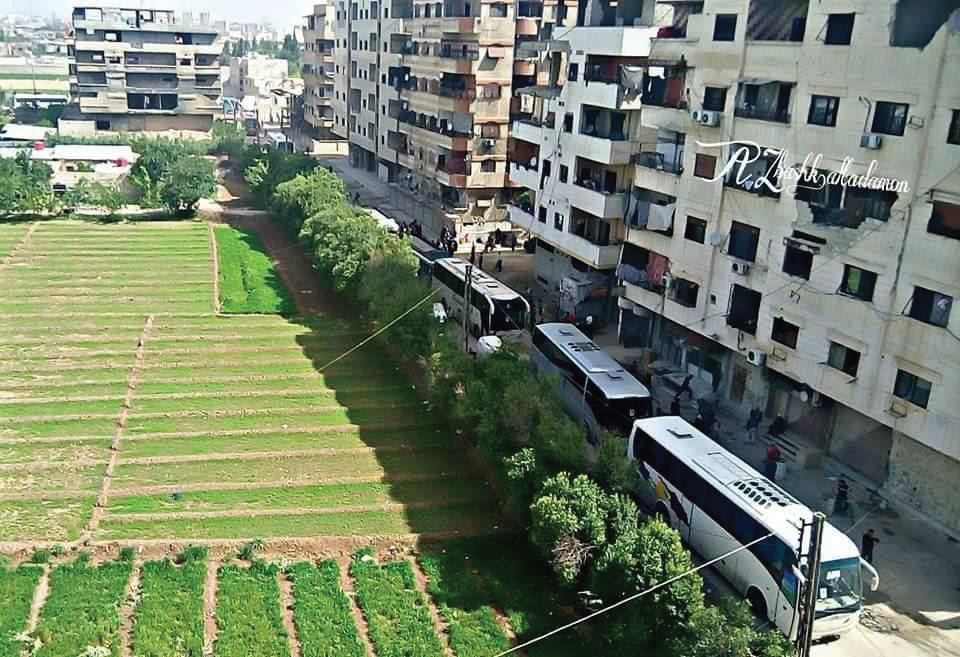
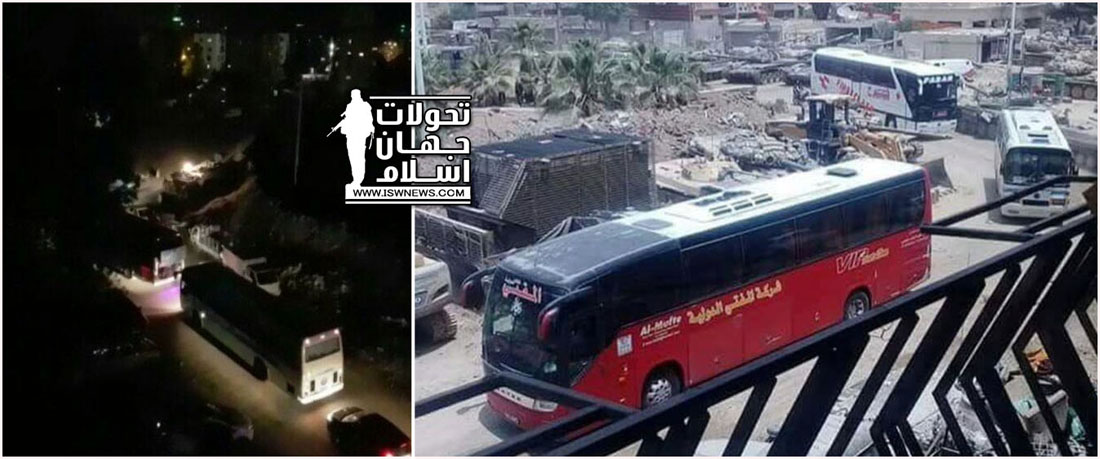

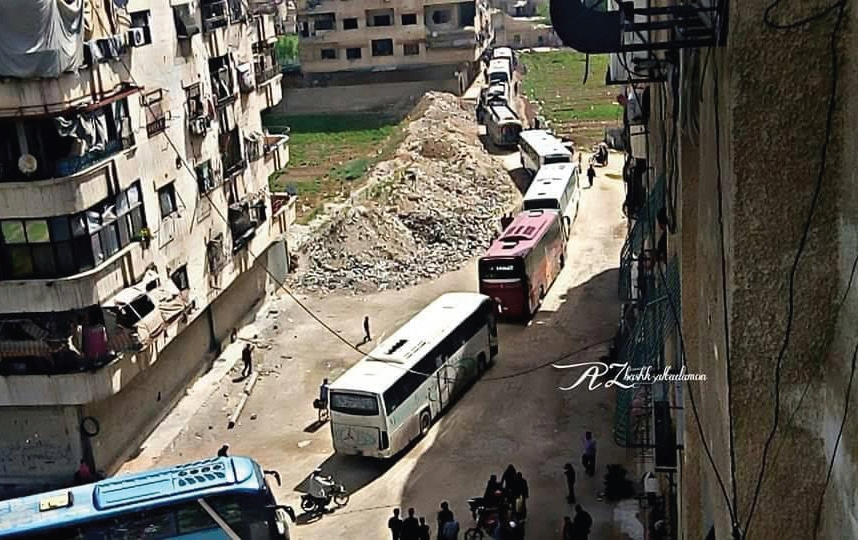
Map No. 11: Yarmouk – Areas of influence between 2017 and May 2018
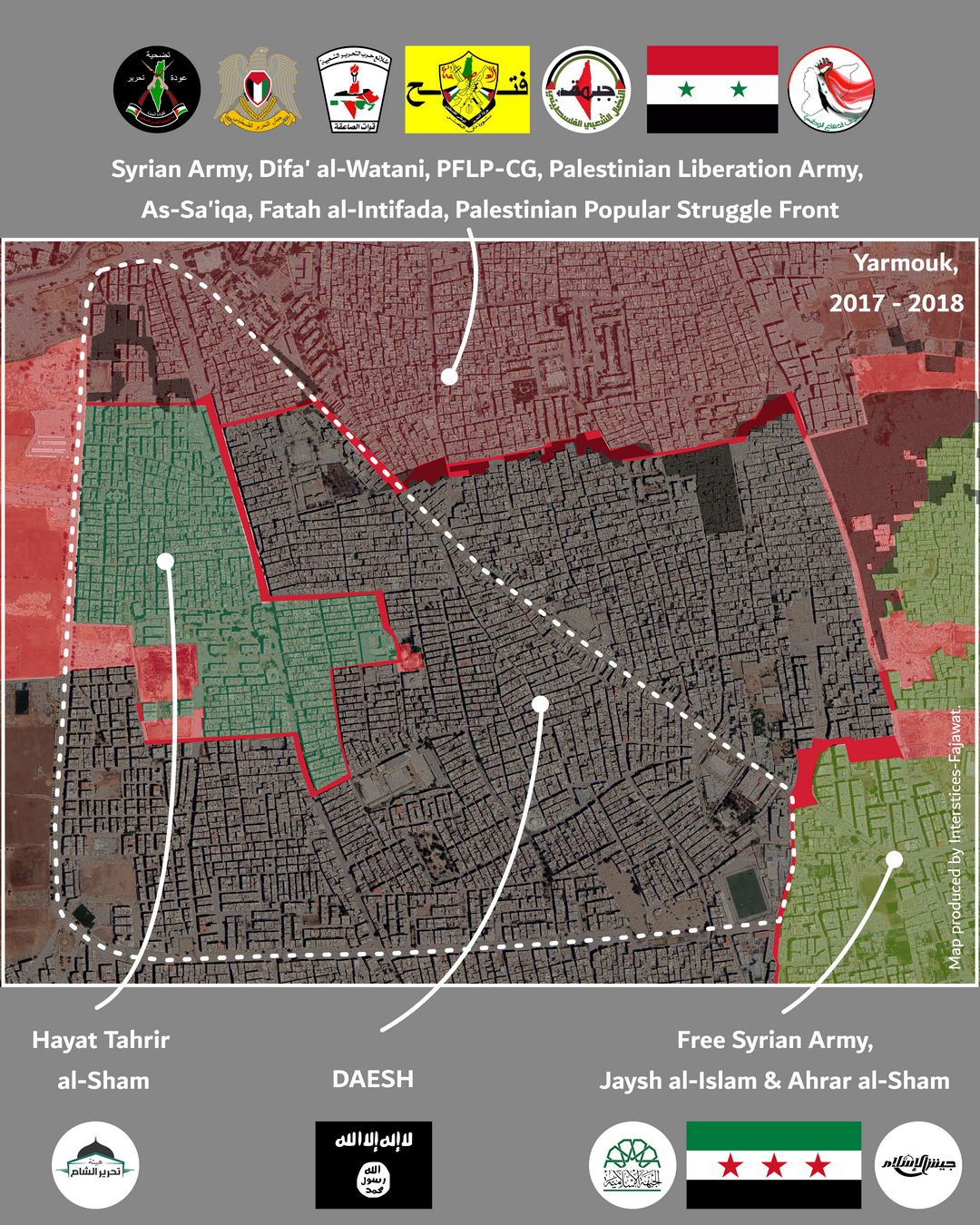
Map No. 12: Yarmouk – Areas of influence between May 2 and May 7, 2018
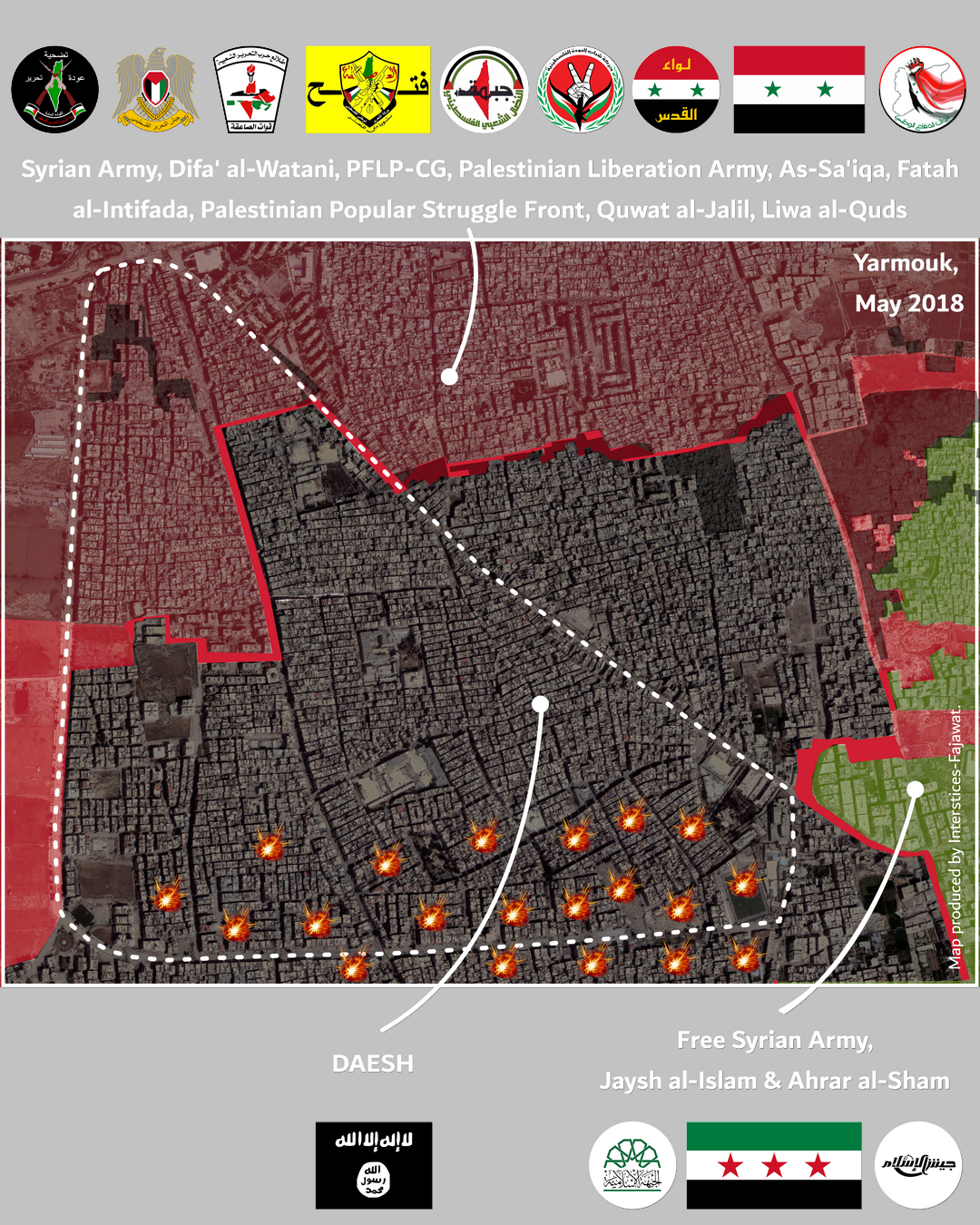
Map No. 13: Yarmouk – Areas of influence between May 10 and May 21, 2018
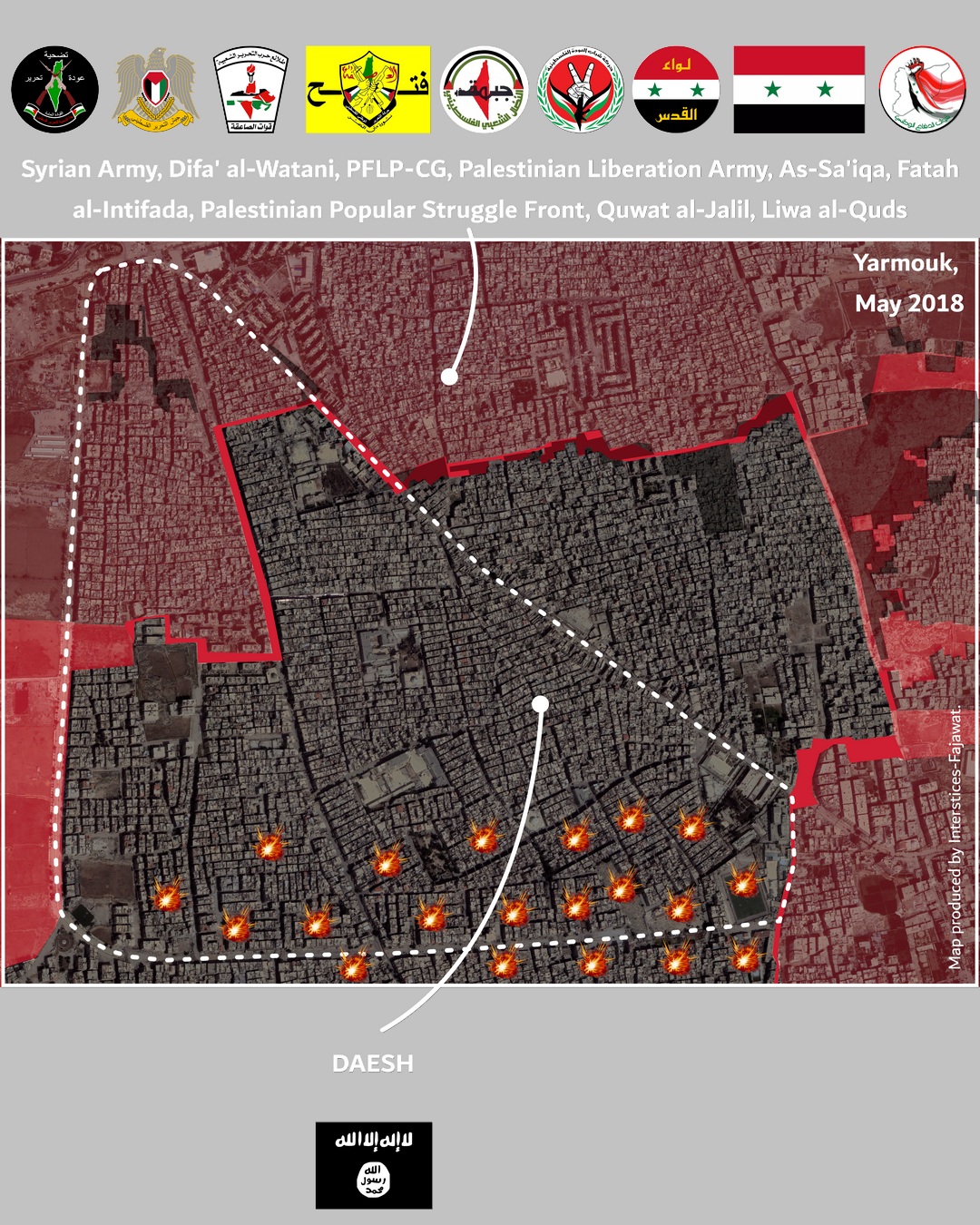
Map No. 14: Yarmouk – Total takeover of Yarmouk by the regime on May 21, 2018
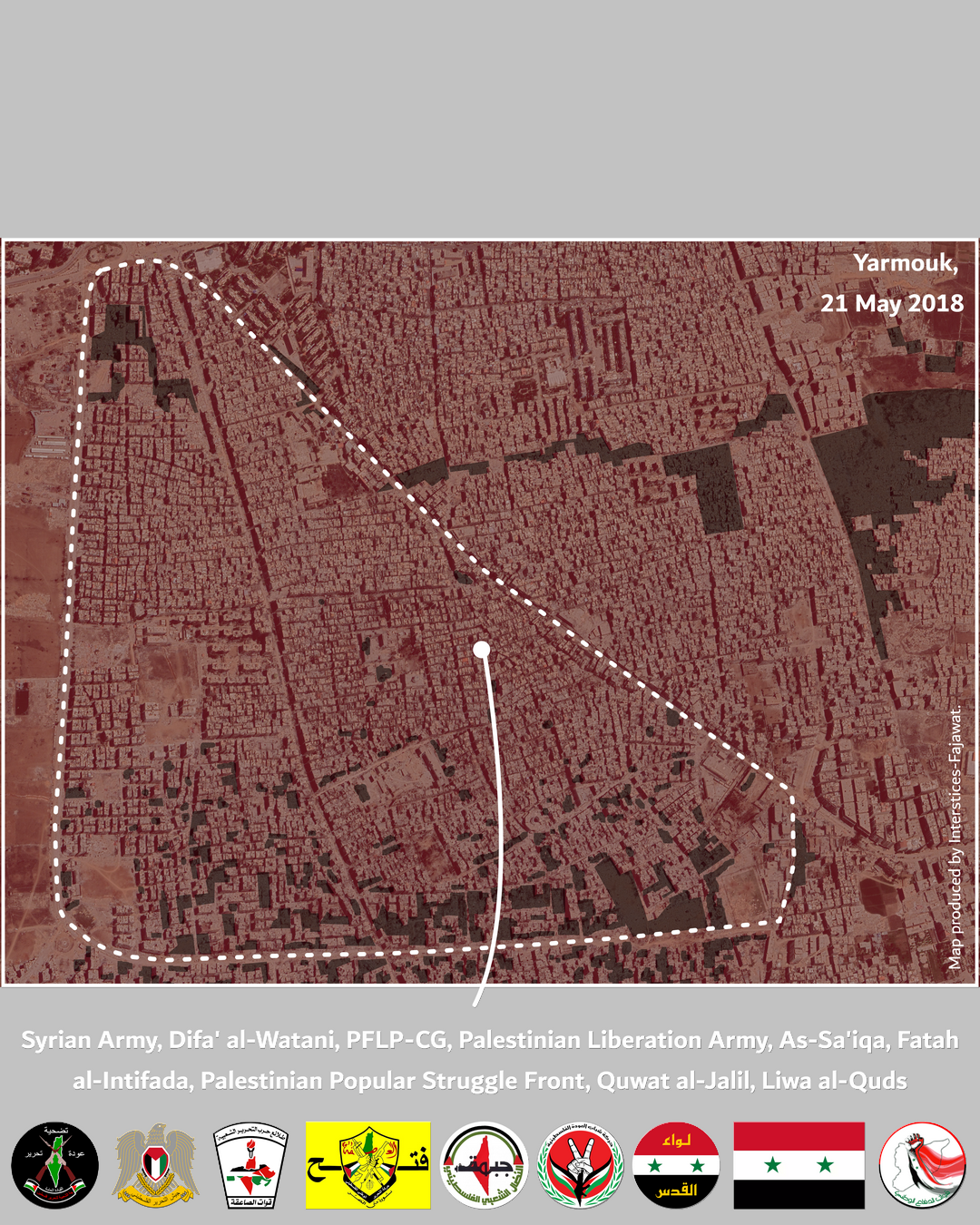
2024: Recovery. Yarmouk, a ghost town.
Over the next five years, only 15,300 residents, 80% of whom were Palestinian refugees, were able to return to their homes (4,500 families) or at least to the ruins of their former homes, after applying for permission to return. This permission was granted sparingly, only to those whose homes were deemed viable and who could provide proof of ownership or other documentation proving their previous residence. Those who had previously been arrested, convicted, called up for military conscription, or had links to the armed factions that had controlled the territory were excluded from the procedure, the latter criterion being entirely subjective and left to the discretion of the Fourth Division agents.
The Rehabilitation Oversight Committee estimated that 40% of the buildings were in good condition, 40% needed reinforcement and repairs, and 20% were completely destroyed and needed to be cleared and rebuilt.
The management of the camp was entrusted to the “General Authority for Palestinian Arab Refugees,” a body under the auspices of the Yarmouk branch of the Ba’ath Party, led by Ali Mustafa. This body was regularly criticized by residents for its inaction and corruption, one of the main problems being the prohibitive prices of real estate and the lack of rehabilitation of vital infrastructure (water, electricity, sewage). The 12 municipal employees were notably accused by residents of blackmail and corruption.
When the regime fell in December 2024, 736 Palestinians from Yarmouk had been taken prisoner and 1,530 killed out of the 1,600 Palestinians from Syria taken prisoner and 3,685 killed since 2011. Among them, 94 members affiliated with Hamas had been executed, including Mamoun Al-Jaloudi. [1] [2]
* * *
Yarmouk is a symbol. The Assad regime must be held primarily responsible for the annihilation of Syria’s largest Palestinian refugee camp, whose violent assault beginning in the second half of 2012 was a continuation of that of the Palestinian camps in Dera’a and Latakia a few months earlier. Contrary to what the regime’s propaganda has repeatedly claimed in order to discredit the popular opposition movements and the armed rebellion, the spread of takfiri/jihadist groups was not the cause and justification for its use of violence, but its consequence: in Yarmouk, Jabhat al-Nusra—along with its offshoots Fatah al-Sham and Hayat Tahrir al-Sham – and the Islamic State took advantage of the vacuum and chaos left by the indiscriminate bombing at the end of 2012, followed by the exhaustion of the anti-Assad Palestinian self-defense militias during the two years of siege that followed, to seize a camp that had been transformed into a ghost town without encountering any resistance. And when their task of eliminating any possibility of future resistance was accomplished, the regime systematically moved them elsewhere by bus so that they could attack other rebel pockets or unyielding communities, as was the case with the Druze of Suwayda in July 2018. Throughout the process of destroying Yarmouk, the Palestinian militias loyal to Assad demonstrated their deep corruption and abject complicity in the regime’s crimes. This position, contrary to the interests of Palestinian civilians, can only be explained by these factions’ desire to preserve their existence and their political and military influence: none of them wanted to suffer the fate of Arafat’s Fatah and its fedayeen. Their survival depended on the regime as much as the regime’s survival depended on Iran and Russia. By allying themselves with the latter to crush Yarmouk, they placed themselves on the same level as Hezbollah and Bashar’s shabiha, serving the interests of their masters rather than those of the people. Paradoxically, the true defenders of the Palestinian people of Yarmouk, members of the Coordination Committees and micro-factions who did not give in to either the regime or the Islamists and fought alongside civilians from within the camp, have been virtually forgotten. It is now up for us to restore their memory.
The Palestinian, Syrian, Lebanese, and Jordanian peoples are one, and everything that divides them is merely the result of Western colonialism and its maneuvers to prevent progressive Arab forces from prevailing over conservative forces. The point of junction between the four peoples lies on the slopes of the Golan Heights, and none of them can be liberated without the liberation of all. It is up to each of us to understand the meaning of this conclusion, at a time when the Zionist colonial army is seizing the Litani and Ruqqad valleys after having militarily annexed those of the Jordan and Arabah.
[1] The New Arab, Nearly 4,000 Palestinians ‘killed’ in Syria’s brutal war, 28 Mars 2018, accessible à https://www.newarab.com/news/nearly-4000-palestinians-killed-syrias-brutal-war
[2] The New Arab, Assad’s regime executed dozens of Hamas members without trial, intelligence documents reveal, 7 Janvier 2025, accessible à https://www.newarab.com/news/dozens-hamas-members-executed-assads-syria-prisons
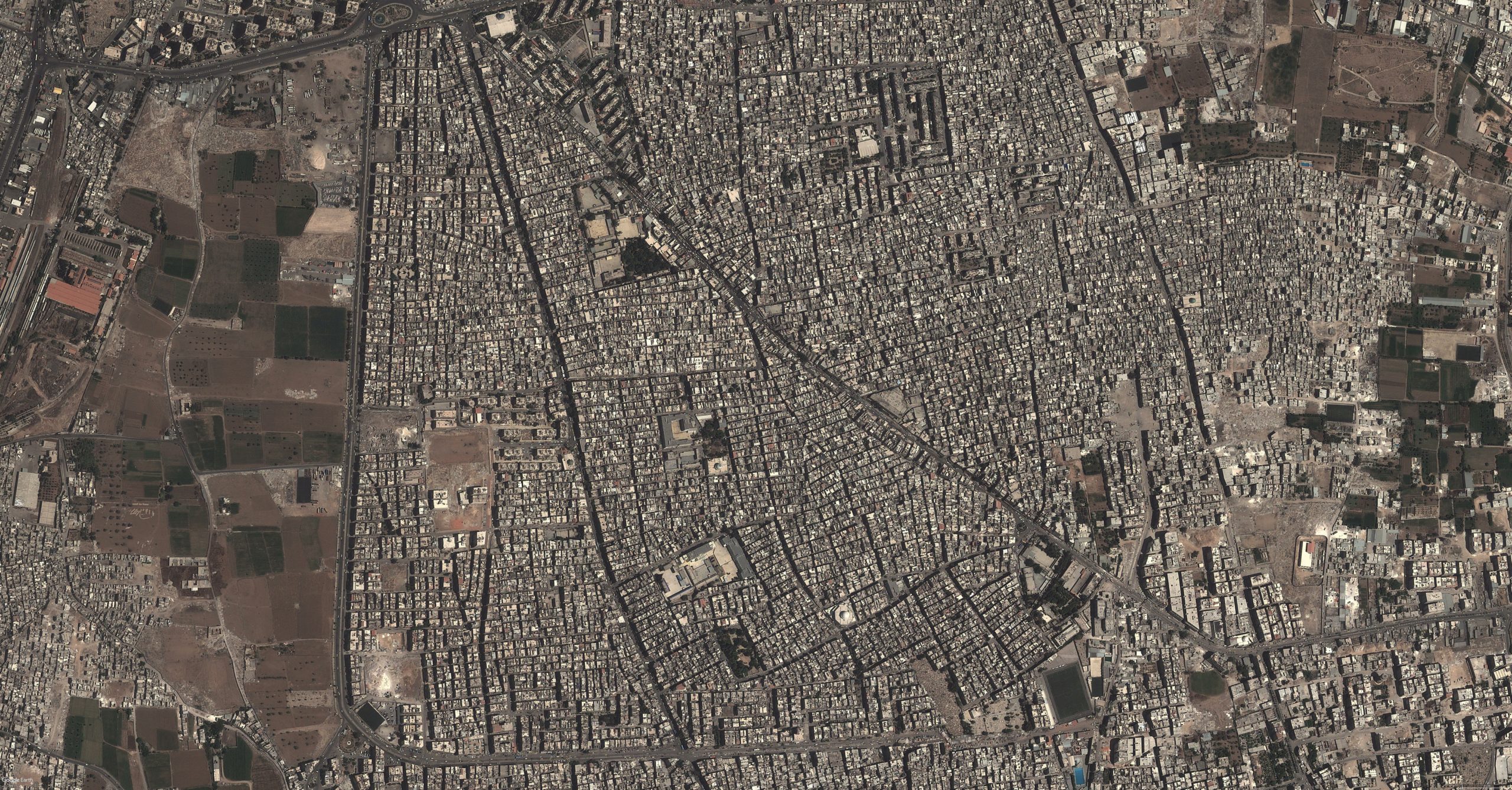

REPORTS ABOUT YARMOUK:
- Palestinians of Syria, Between Bitterness of Reality and the Hope of Return – Action Group for Palestinians in Syria, Juin 2014.
- Palestinians of Syria, The Bleeding Wound – Action Group for Palestinians in Syria, Février 2015
- Yarmouk Siege has not ended – Action Group for Palestinians in Syria, 23 Juin 2015
- Palestinians of Syria, Bloody Diary and Unheard Screaming – Action Group for Palestinians in Syria & Palestinian Return Center, Septembre 2015
- Yarmouk, the Full Truth – Action Group for Palestinians in Syria, Juillet 2015.
- Palestinians of Syria and The Closed Doors – Action Group for Palestinians in Syria, 2017
- Status Report on Yarmouk Camp – The Carter Center, 14 Novembre 2017.
- Yarmouk, The Abandoned Pain – EuroMed Monitor, Juillet 2018.
- Yarmouk Camp set on Fire – Action Group for Palestinians in Syria, Democratic Republic Studies Center, Syrian Center for Media and Freedom of Expression, 22 Avril 2018.
- Status Report on the Conditions of Yarmouk Camp 2024 – Action Group for Palestinians in Syria, Décembre 2024.
























